Paul van Yperen's Blog, page 180
October 25, 2020
Jack Hoxie
Jack Hoxie (1885–1965) was an American rodeo performer and motion picture actor whose career was most prominent in the silent film era of the 1910s through the 1930s. Hoxie is best recalled for his roles in Westerns and rarely strayed from the genre.
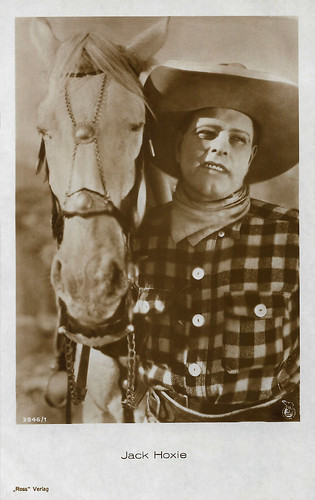
German postcard by Ross Verlag, no. 3546/1, 1928-1929. Photo: Nordisk Films.
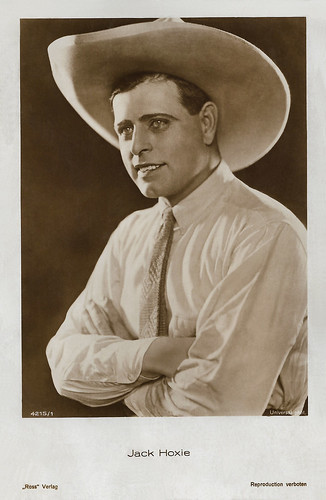
German postcard by Ross Verlag, no. 4215/1, 1929-1930. Photo: Universal.
Touring the rodeo circuit
John Hartford 'Jack' Hoxie was born in 1885 in Kingfisher Creek in the Indian Territory (now the state of Oklahoma). Hoxie was the son of a veterinarian father, Bart 'Doc' Hoxie, and a half–Nez Perce mother (some reports list her as Cherokee), Matilda E. Hoxie (née Quick). Bart was killed in a horse accident just weeks before Jack's birth.
After his father's death, he and his mother moved to Northern Idaho where, at an early age, Jack became a working cowboy and ranch hand. Matilda married a rancher and horse trader named Calvin Scott Stone. The family then relocated to Boise, where Jack worked as a packer for a US Army fort in the area, continuing to hone his skill as a horseback rider while competing in rodeos.
In 1905, the 20-years-old Jack married Pearl Gage. The marriage lasted only a few months before the couple divorced. In 1909 he met performer Dick Stanley and joined his Wild West show. He performed as a bronc rider in the show. It was during this period that Jack met and married his second wife, Hazel Panting, who was a Western trick rider with the outfit.
According to IMDb , he had his first film role in the Western Ridin' Romance (James Young Deer, 1910) for Pathé Exchange. However, it remained for years a one-off role. Hoxie continued to tour the rodeo circuit until 1913.
Then he was approached to perform in the short Western The Tragedy of Big Eagle Mine (N.N., 1913), produced by Kalem. This time his acting was the start of a continuous, highly prolific career. Now billing himself as Hart Hoxie (a moniker he would use until 1919), he would continue working through the 1910s in popular Western shorts, often in small but well-received roles.
First, he did in 1913-1914 a series of Western shorts at Kalem's Glendale premises in California, which were often directed by J.P. McGowan. Initially, Hoxie was the star, but his female co-actor Helen Holmes gradually increased her prominence. In 1914-1915 Hoxie became a supporting actor in Holmes's serial The Hazards of Helen (J. Gunnis Davis, J.P. McGowan, Robert G. Vignola, 1914-1915).
After Kalem, Hoxie worked in 1915-1916 at Bison (part of Universal) and Universal itself, returning to Kalem in 1916 for various supporting parts in the Western thriller series The Girl from Frisco (James W. Horne, 1916), starring Marin Sais. Afterward, various Kalem films followed.
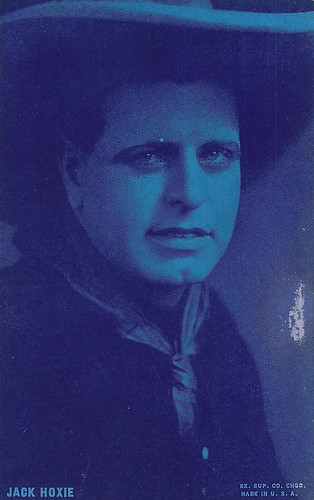
American Arcade card by Ex. Sup. Co. (Exhibition Supply Company), Chicago.
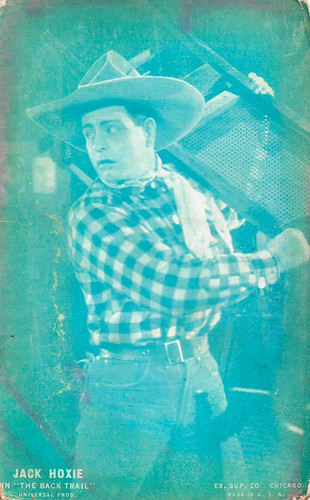
American Arcade card by Ex. Sup. Co. (Exhibition Supply Company), Chicago. Photo: Universal. Jack Hoxie in The Back Trail (George Marshall, Cliford Smith, 1924).
An extremely popular Western star
In 1918 Jack Hoxie had his first starring role in a feature, the Universal production The Wolf and His Mate (Edward LeSaint, 1918). Edward LeSaint also gave him first billing in Nobody's Wife. In these films Hoxie started to use his name Jack Hoxie, as vintage posters show (but Wikipedia and IMDb deny).
In 1919, after appearing in approximately 35 films, he was cast in the starring role in the Paul Hurst-directed Lightning Bryce serials as the main character, Sky Bryce. It was during this time that he met and married his third wife, actress and frequent co-star Marin Sais, after his divorce from Hazel Panting.
Although he rarely strayed from the Western film genre, several notable exceptions include his role as Perrone in the historical drama The Dumb Girl of Portici (1916), starring Anna Pavlova ; a role in the epic drama film Joan the Woman (Cecil B. DeMille, 1916), starring Geraldine Farrar , and his role as Sandusky in the drama Nan of Music Mountain (1917), starring Wallace Reid and Ann Little.
Through the early 1920s, Hoxie became an extremely popular Western star and worked for such film companies as Ben Wilson Productions (distributed by Arrow Film) and Sunset Pictures. In 1923 Universal Pictures head Carl Laemmle put Hoxie under contract and soon his career was on par with that of other Western stars of the era: Art Acord, Harry Carey, and Hoot Gibson .
Hoxie appeared in such high-profile films as Where Is This West? (1923) with newcomer Mary Philbin and Universal's promotional film Hello, 'Frisco (1924), alongside such popular actors of the era as Jackie Coogan , Norman Kerry, Barbara La Marr, Antonio Moreno, Anna Q. Nilsson , Bebe Daniels, and Rin Tin Tin. The film was designed to showcase Universal's roster of its most popular actors.
Hoxie, often atop his horses Fender and Dynamite, would star alongside such actresses as Marceline Day, Alice Day, Helen Holmes, Louise Lovely, Lottie Pickford, and Fay Wray in Westerns throughout the silent era. Also, during this period, Jack's younger half-brother Al Stone began to appear with him in films. Al would eventually become a successful actor in the Western genre after changing his name to Al Hoxie and appearing in a series of films by actor/director J.P. McGowan.
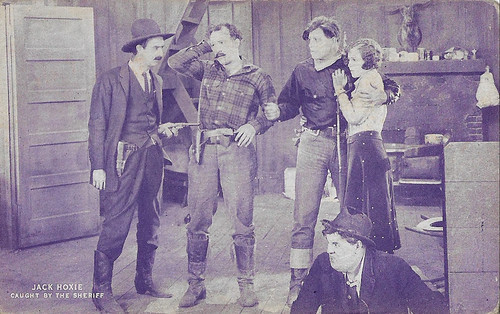
American Arcade card by Ex. Sup. Co. (Exhibition Supply Company), Chicago. Caption: Caught by the Sheriff.
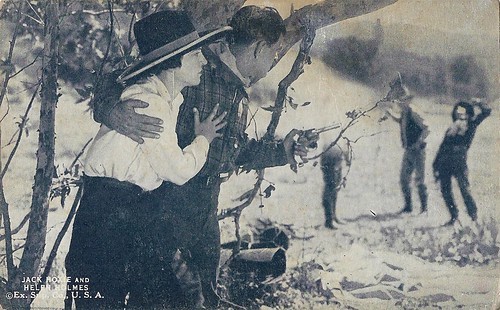
American Arcade card by Ex. Sup. Co. (Exhibition Supply Company), Chicago. Jack Hoxie and Helen Holmes in Highwayman (1926).
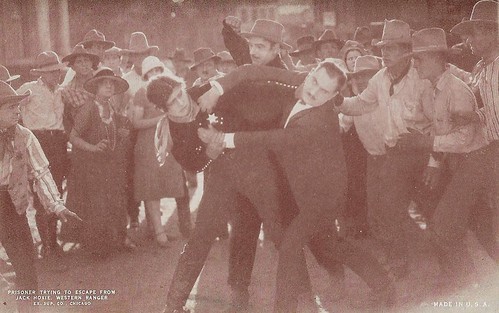
American Arcade card by Ex. Sup. Co. (Exhibition Supply Company), Chicago. Caption: Prisoner Trying to Escape from Jack Hoxie, Western Ranger.
A Star in Life - A Star in Heaven
In 1926 Carl Laemmle and Universal chose Jack Hoxie to star as Buffalo Bill Cody in Metropolitan Pictures' The Last Frontier, co-starring William Boyd. The film would prove enormously successful.
In 1927, however, Hoxie became dissatisfied with his contract at Universal and refused to renegotiate for another stint at the studio. He would continue throughout the late 1920s making films with lower-rank film studios. He made his last silent film, Forbidden Trail, in 1929 before pursuing further work in circuit rodeos, carnivals, and the Miller Brothers 101 Ranch Wild West Show.
During the 1930s Hoxie made a brief comeback in films after signing a contract with low-budget studio Majestic Pictures. The films, however, did little to revive his acting career and he once again hit the rodeo circuit. His last film appearance would be in Trouble Busters (Lewis D. Collins, 1933) with Lane Chandler, who had appeared alongside Hoxie in a number of earlier films.
Hoxie eventually divorced and married his fourth wife, Dixie Starr. The couple briefly operated the Broken Arrow Ranch, a dude ranch in Hereford, Arizona. After a fire consumed the ranch, Hoxie returned to Wild West shows, often billed as the "Famous Western Screen Star". Hoxie performed throughout the 1940s and well into the 1950s before finally making his last public appearance as a performer in 1959 for the Bill Tatum Circus.
Hoxie divorced Starr and married his fifth wife, Bonnie Avis Showalter, and the couple retired to a small ranch in Arkansas, then later moved to his mother Matilda's old homestead in Oklahoma. In his later years, Hoxie developed leukemia, and he died in 1965, in Elkhart, Kansas, at the age of 80. He was interred at the Willowbar Cemetery in Keyes, Oklahoma with the epitaph "A Star in Life - A Star in Heaven".
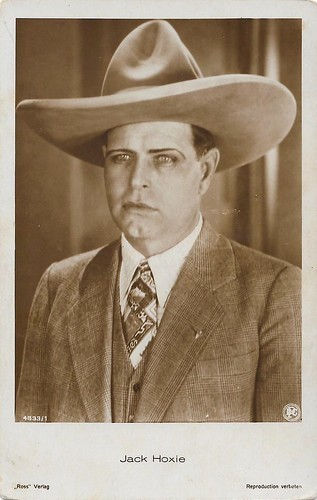
German postcard by Ross Verlag, no. 4833/1, 1929-1930. Photo: DPG.
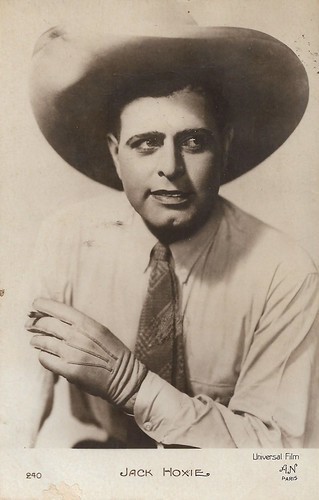
French postcard by A.N. (A. Noyer), no. 240. Photo: Universal Film.
Sources: Wikipedia, and .

German postcard by Ross Verlag, no. 3546/1, 1928-1929. Photo: Nordisk Films.

German postcard by Ross Verlag, no. 4215/1, 1929-1930. Photo: Universal.
Touring the rodeo circuit
John Hartford 'Jack' Hoxie was born in 1885 in Kingfisher Creek in the Indian Territory (now the state of Oklahoma). Hoxie was the son of a veterinarian father, Bart 'Doc' Hoxie, and a half–Nez Perce mother (some reports list her as Cherokee), Matilda E. Hoxie (née Quick). Bart was killed in a horse accident just weeks before Jack's birth.
After his father's death, he and his mother moved to Northern Idaho where, at an early age, Jack became a working cowboy and ranch hand. Matilda married a rancher and horse trader named Calvin Scott Stone. The family then relocated to Boise, where Jack worked as a packer for a US Army fort in the area, continuing to hone his skill as a horseback rider while competing in rodeos.
In 1905, the 20-years-old Jack married Pearl Gage. The marriage lasted only a few months before the couple divorced. In 1909 he met performer Dick Stanley and joined his Wild West show. He performed as a bronc rider in the show. It was during this period that Jack met and married his second wife, Hazel Panting, who was a Western trick rider with the outfit.
According to IMDb , he had his first film role in the Western Ridin' Romance (James Young Deer, 1910) for Pathé Exchange. However, it remained for years a one-off role. Hoxie continued to tour the rodeo circuit until 1913.
Then he was approached to perform in the short Western The Tragedy of Big Eagle Mine (N.N., 1913), produced by Kalem. This time his acting was the start of a continuous, highly prolific career. Now billing himself as Hart Hoxie (a moniker he would use until 1919), he would continue working through the 1910s in popular Western shorts, often in small but well-received roles.
First, he did in 1913-1914 a series of Western shorts at Kalem's Glendale premises in California, which were often directed by J.P. McGowan. Initially, Hoxie was the star, but his female co-actor Helen Holmes gradually increased her prominence. In 1914-1915 Hoxie became a supporting actor in Holmes's serial The Hazards of Helen (J. Gunnis Davis, J.P. McGowan, Robert G. Vignola, 1914-1915).
After Kalem, Hoxie worked in 1915-1916 at Bison (part of Universal) and Universal itself, returning to Kalem in 1916 for various supporting parts in the Western thriller series The Girl from Frisco (James W. Horne, 1916), starring Marin Sais. Afterward, various Kalem films followed.

American Arcade card by Ex. Sup. Co. (Exhibition Supply Company), Chicago.

American Arcade card by Ex. Sup. Co. (Exhibition Supply Company), Chicago. Photo: Universal. Jack Hoxie in The Back Trail (George Marshall, Cliford Smith, 1924).
An extremely popular Western star
In 1918 Jack Hoxie had his first starring role in a feature, the Universal production The Wolf and His Mate (Edward LeSaint, 1918). Edward LeSaint also gave him first billing in Nobody's Wife. In these films Hoxie started to use his name Jack Hoxie, as vintage posters show (but Wikipedia and IMDb deny).
In 1919, after appearing in approximately 35 films, he was cast in the starring role in the Paul Hurst-directed Lightning Bryce serials as the main character, Sky Bryce. It was during this time that he met and married his third wife, actress and frequent co-star Marin Sais, after his divorce from Hazel Panting.
Although he rarely strayed from the Western film genre, several notable exceptions include his role as Perrone in the historical drama The Dumb Girl of Portici (1916), starring Anna Pavlova ; a role in the epic drama film Joan the Woman (Cecil B. DeMille, 1916), starring Geraldine Farrar , and his role as Sandusky in the drama Nan of Music Mountain (1917), starring Wallace Reid and Ann Little.
Through the early 1920s, Hoxie became an extremely popular Western star and worked for such film companies as Ben Wilson Productions (distributed by Arrow Film) and Sunset Pictures. In 1923 Universal Pictures head Carl Laemmle put Hoxie under contract and soon his career was on par with that of other Western stars of the era: Art Acord, Harry Carey, and Hoot Gibson .
Hoxie appeared in such high-profile films as Where Is This West? (1923) with newcomer Mary Philbin and Universal's promotional film Hello, 'Frisco (1924), alongside such popular actors of the era as Jackie Coogan , Norman Kerry, Barbara La Marr, Antonio Moreno, Anna Q. Nilsson , Bebe Daniels, and Rin Tin Tin. The film was designed to showcase Universal's roster of its most popular actors.
Hoxie, often atop his horses Fender and Dynamite, would star alongside such actresses as Marceline Day, Alice Day, Helen Holmes, Louise Lovely, Lottie Pickford, and Fay Wray in Westerns throughout the silent era. Also, during this period, Jack's younger half-brother Al Stone began to appear with him in films. Al would eventually become a successful actor in the Western genre after changing his name to Al Hoxie and appearing in a series of films by actor/director J.P. McGowan.

American Arcade card by Ex. Sup. Co. (Exhibition Supply Company), Chicago. Caption: Caught by the Sheriff.

American Arcade card by Ex. Sup. Co. (Exhibition Supply Company), Chicago. Jack Hoxie and Helen Holmes in Highwayman (1926).

American Arcade card by Ex. Sup. Co. (Exhibition Supply Company), Chicago. Caption: Prisoner Trying to Escape from Jack Hoxie, Western Ranger.
A Star in Life - A Star in Heaven
In 1926 Carl Laemmle and Universal chose Jack Hoxie to star as Buffalo Bill Cody in Metropolitan Pictures' The Last Frontier, co-starring William Boyd. The film would prove enormously successful.
In 1927, however, Hoxie became dissatisfied with his contract at Universal and refused to renegotiate for another stint at the studio. He would continue throughout the late 1920s making films with lower-rank film studios. He made his last silent film, Forbidden Trail, in 1929 before pursuing further work in circuit rodeos, carnivals, and the Miller Brothers 101 Ranch Wild West Show.
During the 1930s Hoxie made a brief comeback in films after signing a contract with low-budget studio Majestic Pictures. The films, however, did little to revive his acting career and he once again hit the rodeo circuit. His last film appearance would be in Trouble Busters (Lewis D. Collins, 1933) with Lane Chandler, who had appeared alongside Hoxie in a number of earlier films.
Hoxie eventually divorced and married his fourth wife, Dixie Starr. The couple briefly operated the Broken Arrow Ranch, a dude ranch in Hereford, Arizona. After a fire consumed the ranch, Hoxie returned to Wild West shows, often billed as the "Famous Western Screen Star". Hoxie performed throughout the 1940s and well into the 1950s before finally making his last public appearance as a performer in 1959 for the Bill Tatum Circus.
Hoxie divorced Starr and married his fifth wife, Bonnie Avis Showalter, and the couple retired to a small ranch in Arkansas, then later moved to his mother Matilda's old homestead in Oklahoma. In his later years, Hoxie developed leukemia, and he died in 1965, in Elkhart, Kansas, at the age of 80. He was interred at the Willowbar Cemetery in Keyes, Oklahoma with the epitaph "A Star in Life - A Star in Heaven".

German postcard by Ross Verlag, no. 4833/1, 1929-1930. Photo: DPG.

French postcard by A.N. (A. Noyer), no. 240. Photo: Universal Film.
Sources: Wikipedia, and .
Published on October 25, 2020 23:00
October 24, 2020
June Haver
American film actress June Haver (1926-2005) was a popular alternative to the musical film stars Betty Grable and Alice Faye in several musicals of the 1940s. Haver's second husband was film star Fred MacMurray, whom she married after she retired from show business.
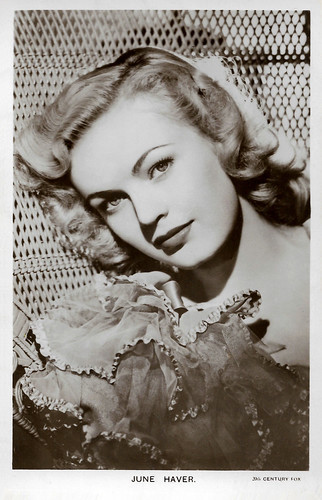
British postcard in the Picturegoer Series, London, no. W. 175. Photo: 20th Century Fox.
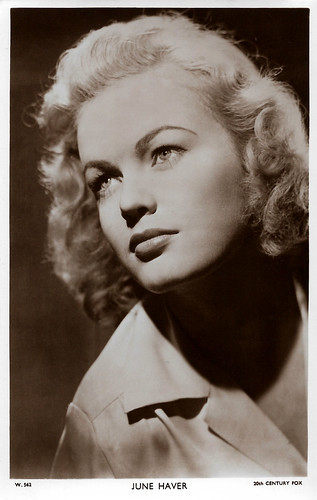
British postcard in the Picturegoer Series, London, no. W. 362. Photo: 20th Century Fox.
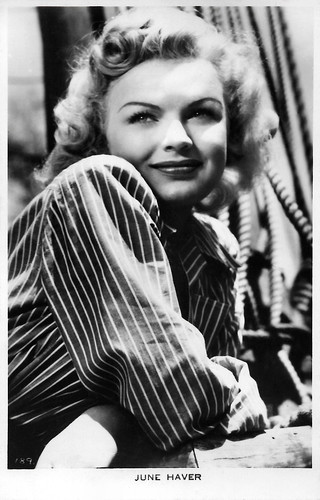
British Real Photograph postcard, no. 189.
A glamour girl stand-in for the studio's two biggest stars
June Haver was born June Stovenour in Rock Island, Illinois. She later took the last name of her stepfather Bert Haver. After the family moved to Ohio, seven-year-old June entered and won a contest of the Cincinnati Conservatory of Music.
Her mother Marie Stovenour being an actress and her stepfather Bert Haver being a musician, Haver often doubted who she - careerwise - wanted to follow. At age eight, she won a film test by imitating famous actresses including Greta Garbo , Katharine Hepburn , and Helen Hayes. Haver's mother, however, prohibited her daughter from becoming a child actress in the film industry, feeling she was too young.
At age 10, she moved back to Rock Island, where she began performing for Rudy Vallee. Working regularly as a band singer by her teens, she performed with the Ted Fio Rito Orchestra for $75 a week. Furthermore, she became a well-known child star on the local radio.
In the summer of 1942, June Haver moved to Hollywood, where she finished high school. She acted in plays in her spare time and during a performance as a southern belle, she was discovered by a scout from 20th Century Fox. In 1943, Haver signed a $3,500 a week contract with the studio and made her film debut playing an uncredited role as a hat-check girl in the musical The Gang's All Here (Busby Berkeley, 1943).
She was dropped shortly after because the studio executives felt that she looked too young, but was later re-signed after her costume and hairstyle were changed. 20th Century Fox had plans to mold Haver as a glamour girl stand-in for the studio's two biggest stars, Betty Grable and Alice Faye. She debuted on-screen in a supporting role as Cri-Cri in Home in Indiana (Henry Hathaway, 1944).
According to the actress, she had just turned seventeen years old when her scenes were filmed. Even before Home in Indiana was released, she was assigned to replace Alice Faye in the Technicolor-musical, Irish Eyes Are Smiling (Gregory Ratoff, 1944). Later that year she co-starred with future husband, Fred MacMurray, in Where Do We Go From Here? (Gregory Ratoff, 1945), which was the only time the pair appeared together in a film.
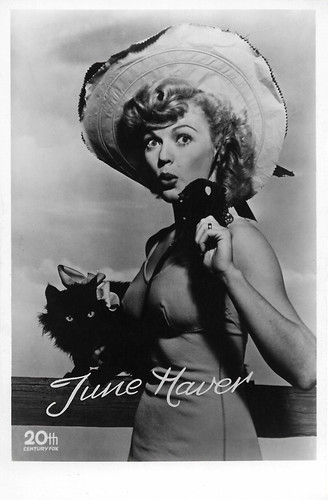
Dutch postcard, no. 3193. Photo: 20th Century Fox.
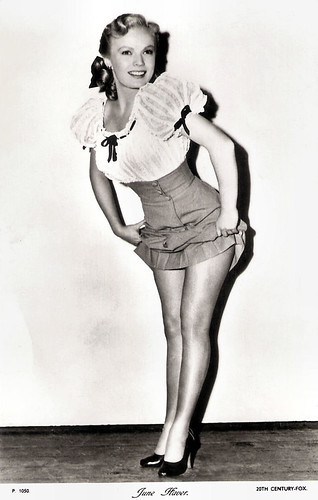
British postcard in The People series by Show Parade Picture Services, London, no. P. 1050. Photo: 20th Century Fox.
I Wonder Who's Kissing Her Now
During her career at Fox, June Haver was originally groomed to be the next Betty Grable (she was known as 'Pocket Grable). She even co-starred with Grable in The Dolly Sisters (Irving Cummings, 1945), a biographical film about Jennie and Rosie Dolly, Hungarian-born identical twins who became famous as entertainers on Broadway and in Europe in the early years of the twentieth century.
In 1946, she starred and received first-billing in Wake Up and Dream (Lloyd Bacon, 1946) with John Payne, and Three Little Girls in Blue (H. Bruce Humberstone, 1946); both of which were well received and brought moderate success.
The following year, the role of Katie was written into the film I Wonder Who's Kissing Her Now (Lloyd Bacon, 1947) just for Haver. In 1947 she married trumpeter Jimmy Zito but they divorced in 1948.
Possibly best known for her roles in optimistic musicals, Haver's comedy star-turn in Scudda Hoo! Scudda Hay! (F. Hugh Herbert, 1948) was a major success. The same year, she starred as Marilyn Miller in the musical Look for the Silver Lining (David Butler, 1949). To resemble the actress as much as possible, Haver had to drive to the studio an hour earlier for make-up.
The following year, she would star in The Daughter of Rosie O'Grady (David Butler, 1950) and I'll Get By (Richard Sale, 1950).
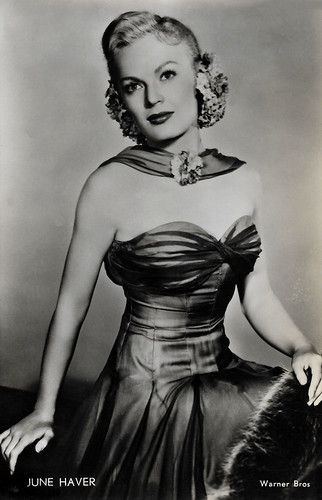
Belgian postcard, no. AX 159. Photo: Warner Bros.
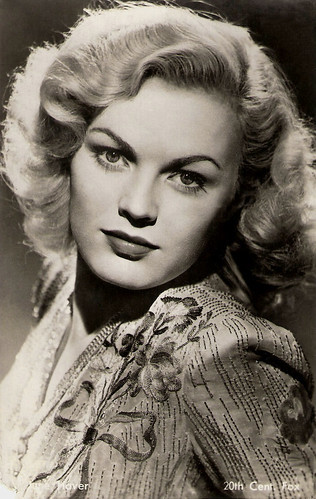
Dutch postcard by DRC, no. 42. Photo: 20th Century Fox / MPEA.
The Sisters of Charity convent
In 1951, June Haver was teamed with Fox's newest asset, Marilyn Monroe , in the low-budget comedy Love Nest (Joseph Newman, 1951). Even though Haver was the lead and received top-billing, most of the film's publicity centered around Monroe, who had a minor role and garnered under-the-title billing.
Love Nest was June Haver's only full-length film in black and white. Her other 15 releases between 1943 and 1953 were shot in three-strip Technicolor, something of a record for a Hollywood Golden Age actress.
In 1952 she became engaged to John Duzik, but the happiness was shortlived. He died less than a year later. In 1953 after her last film role in The Girl Next Door (Richard Sale, 1953) and because of John's death she entered the Sisters of Charity convent in Xavier, Kansas, but she had to leave less than a year later due to an illness she was suffering.
In 1954, she married actor Fred MacMurray. Following her marriage, Haver remained largely retired from acting. Her last appearances were as herself on TV in The Lucy-Desi Comedy Hour (1958) and Disneyland (1959).
Haver and MacMurray would adopt two daughters and remain together until MacMurray's death in 1991. June Haver died from respiratory failure in 2005 at her home in Brentwood, California at the age of 79. She left two stepchildren (by MacMurray's first marriage), her adopted twin daughters, and seven grandchildren.
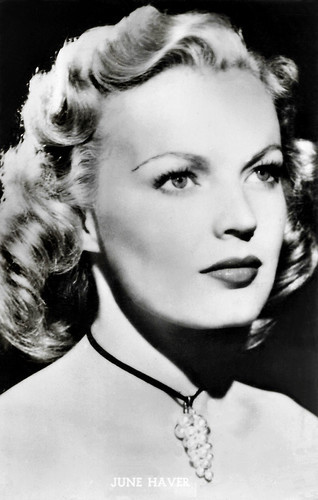
Dutch postcard by Van Leer's Fotodrukindustrie N.V., Amsterdam, no. 331. Photo: Warner Bros.
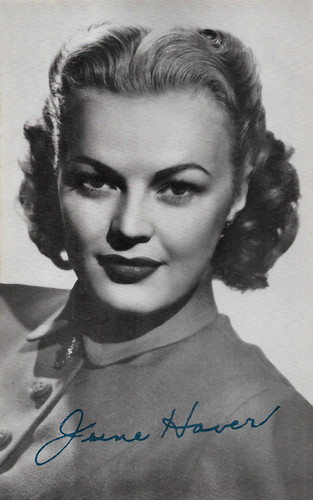
British postcard in the Film Star Autograph Portrait Series by L.D. Ltd, London, no. 88. Photo: 20th Century Fox.
Source: (IMDb), Find A Grave, Wikipedia, and .

British postcard in the Picturegoer Series, London, no. W. 175. Photo: 20th Century Fox.

British postcard in the Picturegoer Series, London, no. W. 362. Photo: 20th Century Fox.

British Real Photograph postcard, no. 189.
A glamour girl stand-in for the studio's two biggest stars
June Haver was born June Stovenour in Rock Island, Illinois. She later took the last name of her stepfather Bert Haver. After the family moved to Ohio, seven-year-old June entered and won a contest of the Cincinnati Conservatory of Music.
Her mother Marie Stovenour being an actress and her stepfather Bert Haver being a musician, Haver often doubted who she - careerwise - wanted to follow. At age eight, she won a film test by imitating famous actresses including Greta Garbo , Katharine Hepburn , and Helen Hayes. Haver's mother, however, prohibited her daughter from becoming a child actress in the film industry, feeling she was too young.
At age 10, she moved back to Rock Island, where she began performing for Rudy Vallee. Working regularly as a band singer by her teens, she performed with the Ted Fio Rito Orchestra for $75 a week. Furthermore, she became a well-known child star on the local radio.
In the summer of 1942, June Haver moved to Hollywood, where she finished high school. She acted in plays in her spare time and during a performance as a southern belle, she was discovered by a scout from 20th Century Fox. In 1943, Haver signed a $3,500 a week contract with the studio and made her film debut playing an uncredited role as a hat-check girl in the musical The Gang's All Here (Busby Berkeley, 1943).
She was dropped shortly after because the studio executives felt that she looked too young, but was later re-signed after her costume and hairstyle were changed. 20th Century Fox had plans to mold Haver as a glamour girl stand-in for the studio's two biggest stars, Betty Grable and Alice Faye. She debuted on-screen in a supporting role as Cri-Cri in Home in Indiana (Henry Hathaway, 1944).
According to the actress, she had just turned seventeen years old when her scenes were filmed. Even before Home in Indiana was released, she was assigned to replace Alice Faye in the Technicolor-musical, Irish Eyes Are Smiling (Gregory Ratoff, 1944). Later that year she co-starred with future husband, Fred MacMurray, in Where Do We Go From Here? (Gregory Ratoff, 1945), which was the only time the pair appeared together in a film.

Dutch postcard, no. 3193. Photo: 20th Century Fox.

British postcard in The People series by Show Parade Picture Services, London, no. P. 1050. Photo: 20th Century Fox.
I Wonder Who's Kissing Her Now
During her career at Fox, June Haver was originally groomed to be the next Betty Grable (she was known as 'Pocket Grable). She even co-starred with Grable in The Dolly Sisters (Irving Cummings, 1945), a biographical film about Jennie and Rosie Dolly, Hungarian-born identical twins who became famous as entertainers on Broadway and in Europe in the early years of the twentieth century.
In 1946, she starred and received first-billing in Wake Up and Dream (Lloyd Bacon, 1946) with John Payne, and Three Little Girls in Blue (H. Bruce Humberstone, 1946); both of which were well received and brought moderate success.
The following year, the role of Katie was written into the film I Wonder Who's Kissing Her Now (Lloyd Bacon, 1947) just for Haver. In 1947 she married trumpeter Jimmy Zito but they divorced in 1948.
Possibly best known for her roles in optimistic musicals, Haver's comedy star-turn in Scudda Hoo! Scudda Hay! (F. Hugh Herbert, 1948) was a major success. The same year, she starred as Marilyn Miller in the musical Look for the Silver Lining (David Butler, 1949). To resemble the actress as much as possible, Haver had to drive to the studio an hour earlier for make-up.
The following year, she would star in The Daughter of Rosie O'Grady (David Butler, 1950) and I'll Get By (Richard Sale, 1950).

Belgian postcard, no. AX 159. Photo: Warner Bros.

Dutch postcard by DRC, no. 42. Photo: 20th Century Fox / MPEA.
The Sisters of Charity convent
In 1951, June Haver was teamed with Fox's newest asset, Marilyn Monroe , in the low-budget comedy Love Nest (Joseph Newman, 1951). Even though Haver was the lead and received top-billing, most of the film's publicity centered around Monroe, who had a minor role and garnered under-the-title billing.
Love Nest was June Haver's only full-length film in black and white. Her other 15 releases between 1943 and 1953 were shot in three-strip Technicolor, something of a record for a Hollywood Golden Age actress.
In 1952 she became engaged to John Duzik, but the happiness was shortlived. He died less than a year later. In 1953 after her last film role in The Girl Next Door (Richard Sale, 1953) and because of John's death she entered the Sisters of Charity convent in Xavier, Kansas, but she had to leave less than a year later due to an illness she was suffering.
In 1954, she married actor Fred MacMurray. Following her marriage, Haver remained largely retired from acting. Her last appearances were as herself on TV in The Lucy-Desi Comedy Hour (1958) and Disneyland (1959).
Haver and MacMurray would adopt two daughters and remain together until MacMurray's death in 1991. June Haver died from respiratory failure in 2005 at her home in Brentwood, California at the age of 79. She left two stepchildren (by MacMurray's first marriage), her adopted twin daughters, and seven grandchildren.

Dutch postcard by Van Leer's Fotodrukindustrie N.V., Amsterdam, no. 331. Photo: Warner Bros.

British postcard in the Film Star Autograph Portrait Series by L.D. Ltd, London, no. 88. Photo: 20th Century Fox.
Source: (IMDb), Find A Grave, Wikipedia, and .
Published on October 24, 2020 23:00
October 23, 2020
More Cinémagazine postcards, Part 1
Five years ago, we did a post about Cinémagazine. Cinémagazine-Edition or CE was a small French publishing company, located in Paris, which had a good reputation. Cinémagazine's star postcards from the 1920s and 1930s are still mesmerising. Since then, we found a lot of Cinémagazine postcards which we like to share with you in two posts. In this first post the original postcards of the 1920s, in a sepia brown tone and without a frame.

French postcard by Cinémagazine-Edition, Paris, no. 14.
Pearl White (1889-1938) was dubbed 'Queen of the Serials", and noted for doing her own stunts, in silent film serials such as The Perils of Pauline (1914) and The Exploits of Elaine (1914-15). Many episodes ended with a literal cliffhanger. In Europe, The Exploits of Elaine were re-edited with two subsequent serials into Les Mystères de New York. Until the end of the First World War, White remained globally a popular action heroine.
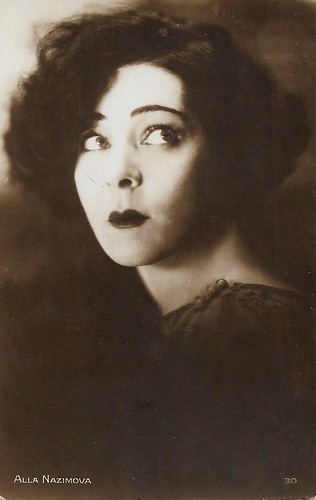
French postcard by Cinémagazine-Edition, Paris, no. 30.
Alla Nazimova (1879–1945) was a grand, highly flamboyant star of the American silent cinema. The Russian-born film and theatre actress, screenwriter, and film producer was widely known as just Nazimova. On Broadway, she was noted for her work in the classic plays of Ibsen, Chekhov, and Turgenev. Her efforts at silent film production were less successful, but a few sound-film performances survive as a record of her art.
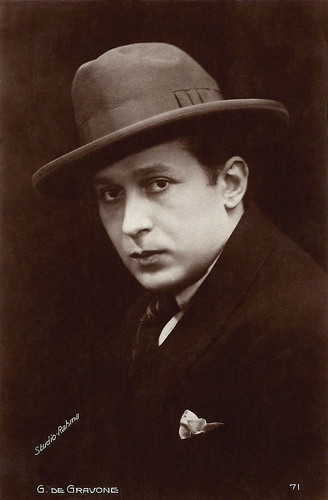
French postcard by Cinémagazine-Edition, Paris, no. 71. Photo: Studio Rahma.
Gabriel de Gravone aka Gabriel de Gravonne (1887-1972) was an actor of French silent cinema. He is most known as Élie, the son of Sisif (Séverin-Mars) in Abel Gance’s La Roue (1920-1923).
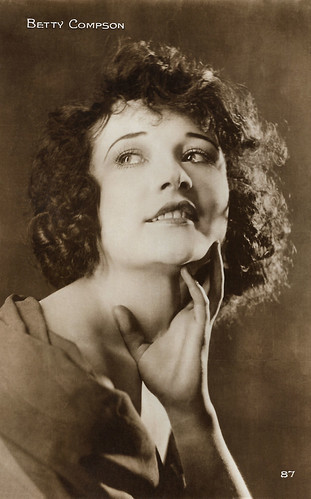
French postcard by Cinémagazine-Edition, Paris, no. 87.
Betty Compson (1897–1974) was an American actress and film producer. She peaked in silent cinema and early talkies, and is best known for her performances as a suicidal prostitute rescued by a stoker (George Bancroft) in The Docks of New York (Joseph Von Sternberg, 1928), and as the manipulative carnival girl Carrie in the part-talkie The Barker (George Fitzmaurice, 1928), the latter earning a nomination for the Academy Award for Best Actress.
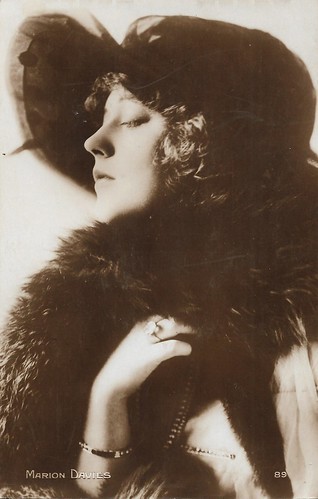
French postcard by Cinémagazine-Edition, Paris, no. 89.
Marion Davies (1897-1961) was one of the great comedic actresses of the silent era. She starred in nearly four dozen films between 1917 and 1937.
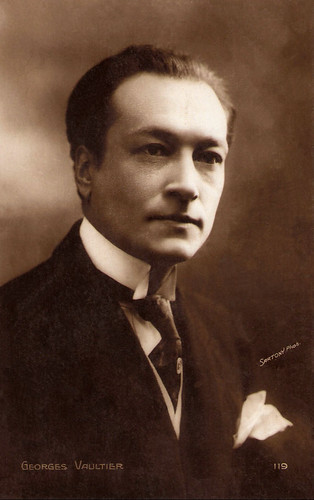
French postcard by Cinémagazine-Edition, Paris, no. 119. Photo: Sartony.
Georges Vaultier (1885-1926) was a French film actor, known for such films as Koenigsmark (1923), L'enfant roi (1923), Auf Befehl der Pompadour (1924), and Le fantôme du Moulin-Rouge (1925).
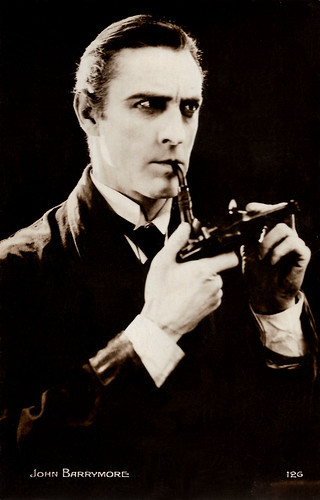
French postcard by Editions Cinémagazine, no. 126. John Barrymore in Sherlock Holmes (Albert Parker, 1922).
John Barrymore (1882-1942) was an American stage and screen actor whose rise to superstardom and subsequent decline is one of the legendary tragedies of Hollywood. A member of the most famous generation of the most famous theatrical family in America, he was also its most acclaimed star. He excelled in high drama, in productions of 'Justice' (1916), 'Richard III' (1920) and 'Hamlet' (1922). After a success as Hamlet in London in 1925, Barrymore left the stage for 14 years and instead focused entirely on films.
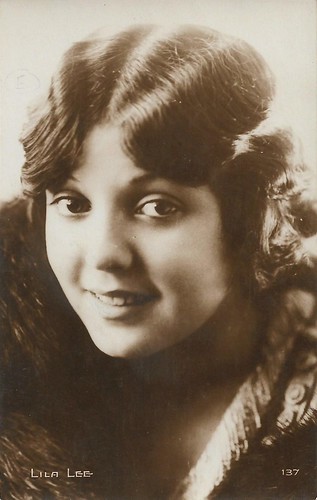
French postcard by Cinémagazine-Edition, Paris, no. 137.
Lila Lee (1901–1973) was a prominent screen actress, primarily a leading lady, of the silent film and early sound film eras.
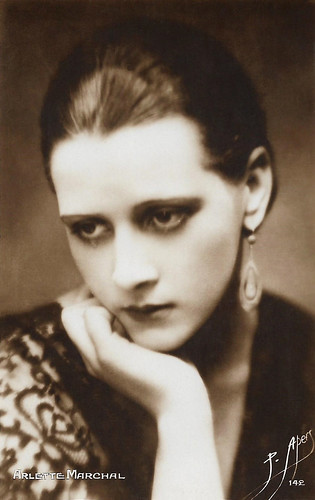
French postcard by Editions Cinémagazine, no. 142. Photo: P. Apers.
Elegant French actress Arlette Marchal (1902-1984) started as a fashion model and from the 1950s on she dedicated herself mostly to her fashion enterprise. Between 1922 and 1951 she starred in 41 European and American films.
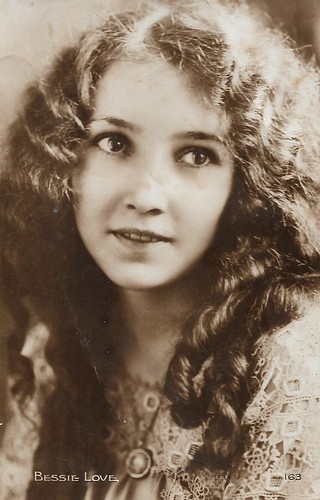
French postcard by Editions Cinémagazine, no. 163.
American actress Bessie Love (1898-1986) was introduced to the cinema by D.W. Griffith. He also gave the actress her screen name. She played innocent young girls and wholesome leading ladies in silent films and early talkies. Her acting career spanned eight decades, and her role in The Broadway Melody (1929) earned her a nomination for the Oscar for Best Actress.
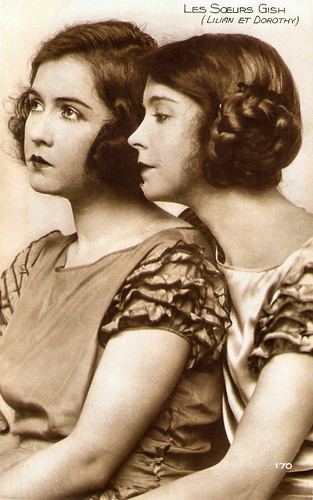
French postcard by Cinémagazine-Edition, Paris, no. 170. Caption: The Gish sisters (Lilian and Dorothy).
American actress Dorothy Gish (1898-1968) and her sister Lilian Gish (1893-1993) were both popular Hollywood stars of the silent era. D.W. Griffith discovered the two girls in 1912 and they starred in his epics Hearts of the World (1918) and Orphans of the Storm (1921).

French postcard by Cinémagazine-Edition, no. 183.
American film actor Tom Mix (1880–1940) was the star of many early Westerns between 1909 and 1935. Mix appeared in 291 films, all but nine of which were silent movies. He was Hollywood's first Western megastar and helped to define the genre for all cowboy actors who followed.
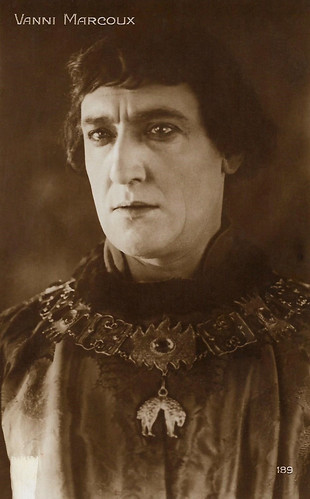
French postcard by Cinémagazine-Edition, no. 189. Vanni Marcoux as Charles le Téméraire (Charles the Bold) in the French silent film Le Miracle des Loups (Raymond Bernard, 1924).
Jean-Émile Diogène Marcoux (1877–1962) was a French operatic bass-baritone, known professionally as Vanni Marcoux (aka Vanni-Marcoux), and renown as one of the most memorable singing-actors of the 20th century. Vanni Marcoux only acted in 4 films, but these were leads as Faust in Don Juan et Faust (Marcel L'Herbier, 1922), as Maurice Ferrioul in the Franco-British coproduction The Scandal (Arthur Rooke, 1923), as Charles le Téméraire in Le Miracle des Loups (Raymond Bernard, 1924), and as Vitalis in Sans famille (Marc Allégret, 1934).

French postcard by Cinémagazine-Edition, Paris, no. 218.
American silent film actress Betty Blythe (1893-1972) was a brunette, buxom matinee idol. She capitalised on the 'roaring 1920s' infatuation with exotic screen sirens to achieve a brief period of stardom. Betty was notorious as one of the first actresses to appear (semi-)nude on screen in The Queen of Sheba (1922). Over the course of her career, she acted in 63 silent and 56 sound films.
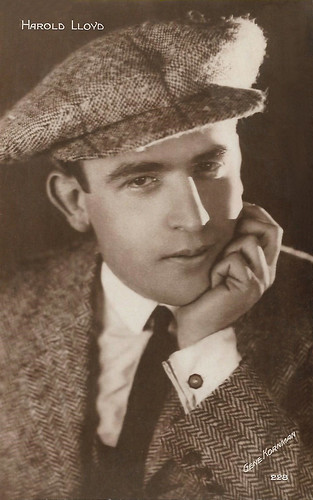
French postcard by Cinémagazine-Edition, no. 228. Photo: Gene Kornman.
American actor, comedian, director, producer, screenwriter, and stunt performer Harold Lloyd (1893-1971) is best known for his silent comedies. He ranks alongside Charlie Chaplin and Buster Keaton as one of the three most popular and influential comedians of the silent film. Between 1914 and 1947, Lloyd made nearly 200 comedies, often as a bespectacled 'Glass' character, a resourceful, success-seeking go-getter who was perfectly in tune with 1920s-era United States. His films frequently contained 'thrill sequences' of extended chase scenes and daredevil physical feats. A classic is Lloyd hanging from the hands of a clock high above the street in Safety Last! (1923).
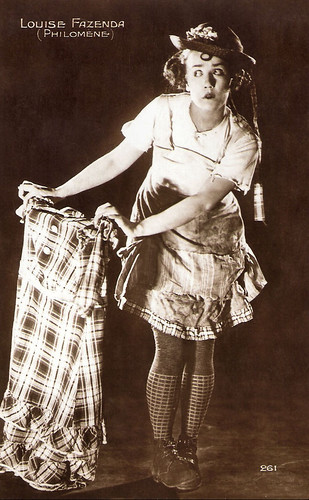
French postcard by Editions Cinémagazine, no. 261. Louise Fazenda was called in France Philomène.
Louise Fazenda (1895-1962) was a gawky, highly popular funny girl in slapstick comedies for Keystone Studios. She paired up well with comedian Charlie Murray. Her best-known character was her country bumpkin - complete with spit curls, multiple pigtails, and calico dresses. In the early 1920s, Louise left Mack Sennett's company and progressed to feature films, where her eccentric talents were greatly utilised in musicals and knockabout comedies.
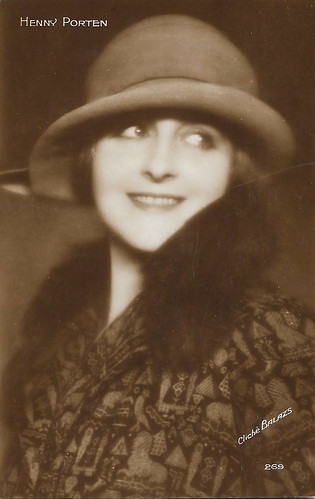
French postcard by Cinémagazine-Edition, no. 269. Photo: Balazs.
Sturdy and blond Henny Porten (1890-1960) was one of Germany's most important and popular film actresses of the silent cinema. She became the quintessence of German womanhood, ladylike yet kindhearted and a not a little petit bourgeois. She was also the producer of many of her own films.
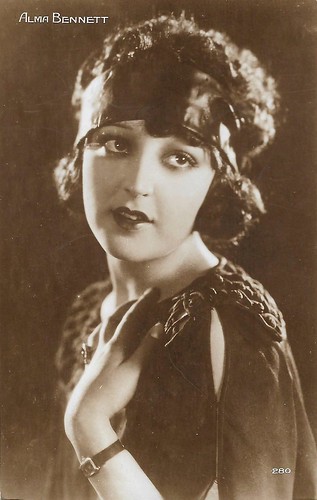
French postcard by Cinémagazine-Edition, no. 280.
Alma Bennett (1904-1958) was an American film actress of the silent era, who appeared in 64 films between 1915 and 1931.
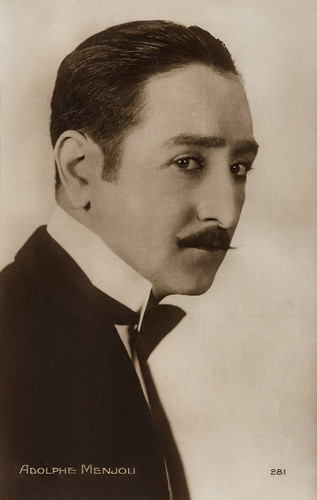
French postcard by Cinémagazine-Edition, no. 281.
Suave and debonair American actor Adolphe Menjou (1890-1963) with his trademark waxy black mustache was one of Hollywood's most distinguished stars and one of America's 'Best Dressed Men'. He started as a matinée idol in the silent cinema in such classics as Ernst Lubitsch's The Marriage Circle (1924). His sound films included Morocco (1931) with Marlene Dietrich and Gary Cooper, A Star is Born (1937), and Stanley Kubrick's Paths of Glory (1957) with Kirk Douglas. In 1931, he was nominated for an Oscar for The Front Page (1931).
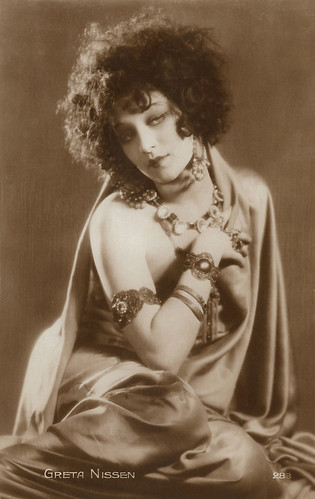
French postcard by Cinémagazine-Edition, no. 283. Photo: Paramount. Greta Nissen in The Wanderer (Raoul Walsh, 1925).
Blonde Norwegian-American bombshell Greta Nissen (1906-1988) is mostly remembered for a role she didn't play; or, rather, a role that was eventually re-filmed with someone else.
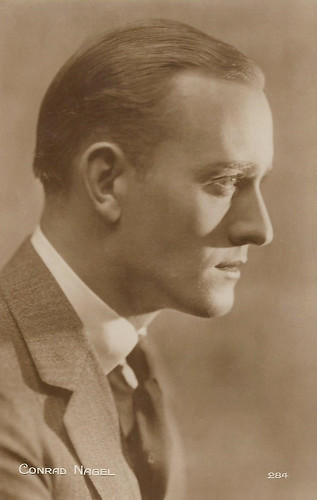
French postcard by Cinémagazine-Edition, no. 284.
American actor Conrad Nagel (1897-1970) was a tall, blue-eyed matinee idol of the 1920s. He successfully made the transition to sound film.
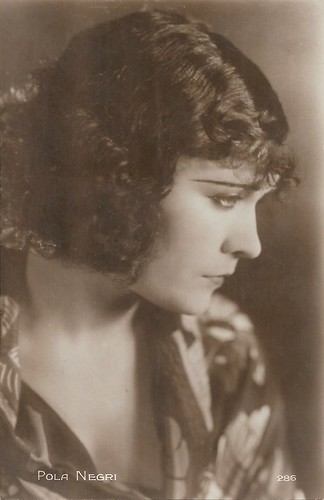
French postcard by Cinémagazine-Edition, Paris, no. 286.
Polish film actress Pola Negri (1897-1987) achieved fame and notoriety as a femme fatale in German and American silent films between the 1910s and 1930s. Negri was an overnight sensation in Ernst Lubitsch' Madame du Barry/Passion (1919). She moved to Hollywood where she lived in a palace, modeled after the White House.
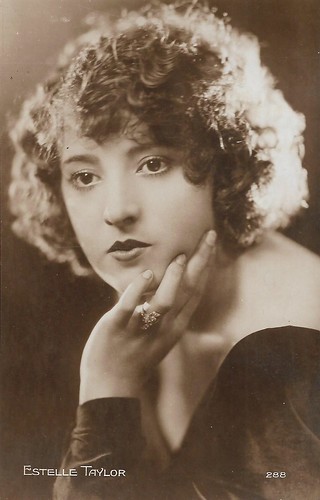
French postcard by Cinémagazine-Edition, Paris, no. 288.
Estelle Taylor (1894–1958) was an American actress, singer, model, and animal rights activist. With her "dark-brown, almost black hair, and brown eyes", she was regarded as one of the most beautiful silent film stars of the 1920s.
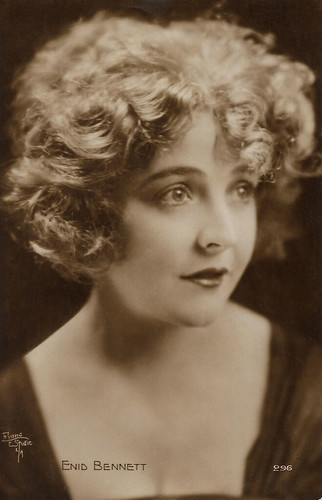
French postcard by Cinémagazine-Edition, no. 296. Photo: Evans Studio, L.A.
Enid Bennett (1893-1969) was an Australian-born silent film actress, mostly active in the American cinema. She peaked in the late 1910s and early 1920s with films such as Robin Hood (1922), starring Douglas Fairbanks, and The Sea Hawk (1924). In the sound era, she played Jackie Coogan's mother in the Oscar-winning film Skippy (1931). She was the wife of director Fred Niblo and after his death of director Sidney Franklin.
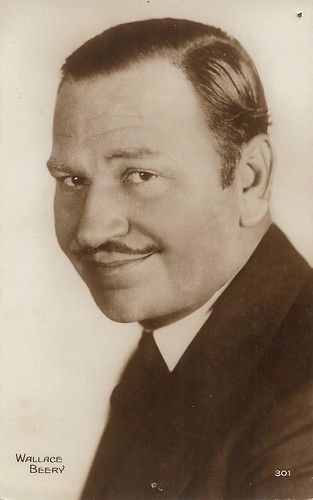
French postcard by Editions Cinémagazine, no. 301.
American actor Wallace Beery (1885-1949) is best known for his portrayal of Bill in Min and Bill opposite Marie Dressler, as Long John Silver in Treasure Island, as Pancho Villa in Viva Villa!, and his titular role in The Champ, for which he won the Academy Award for Best Actor. Beery appeared in some 250 films in a 36-year career. He was the brother of actor Noah Beery, Sr. and uncle of actor Noah Beery, Jr.
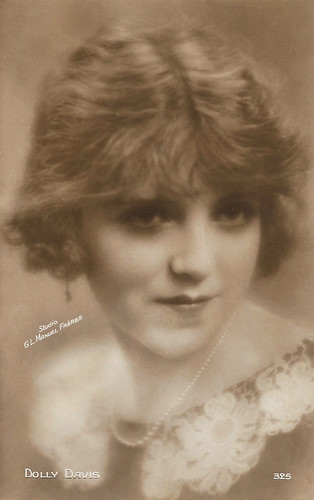
French postcard by Editions Cinémagazine, no. 325. Photo: Studio G.L. Manuel Frères.
French actress Dolly Davis (1896-1962) was a very popular comédienne in the 1920s, who was often paired with her then companion André Roanne. They even starred together in a film simply called Dolly (Pierre Colombier, 1928).
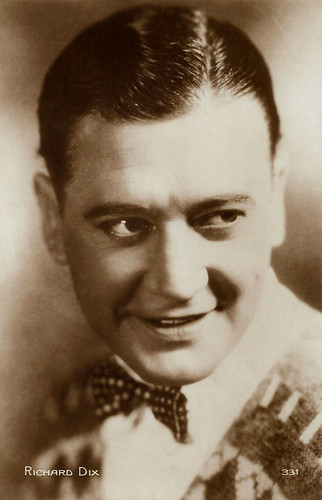
French postcard by Cinémagazine-Edition, Paris, no. 331.
American film actor Richard Dix (1893–1949) achieved popularity in both silent and sound film, first as the rugged and stalwart hero in countless Westerns, then dramatic features such as Cecil B. DeMille's The Ten Commandments (1923). After his years of silent film at Paramount, and thanks to his deep voice and commanding presence, he became a well-known star at RKO in the 1930s. He was nominated for the Academy Award for Best Actor for his lead role in the Best Picture-winning epic, Cimarron (1931).
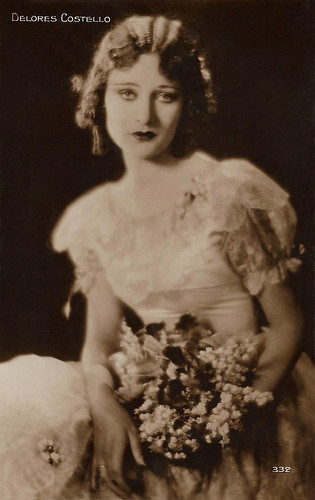
French postcard by Editions Cinémagazine, no. 332. NB Costello's first name is misspelled on the postcard.
American film actress Dolores Costello (1903-1979) was 'The Goddess of the Silent Screen'. She was Hollywood royalty: the daughter of popular matinee idol Maurice Costello, wife of John Barrymore and grandmother of Drew Barrymore.
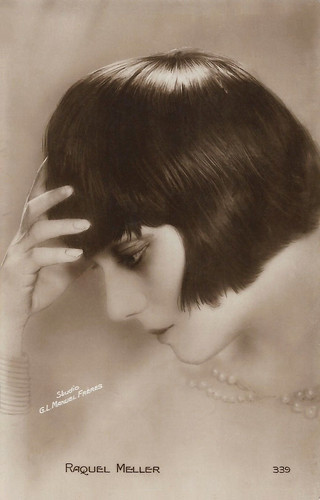
French postcard by Editions Cinémagazine, no. 339. Photo: Studio G.L. Manuel Frères.
Spanish actress, singer, and diva Raquel Meller acted mainly in French silent films. She was already a highly popular singer before debuting as a film actress in 1919.
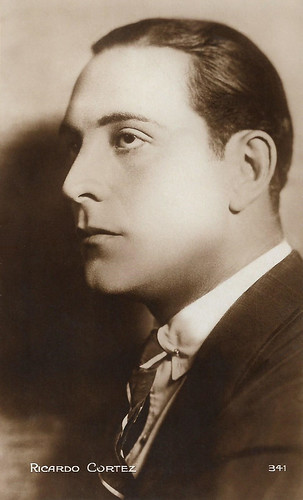
French postcard by Editions Cinémagazine, no. 341.
Suave, dark-haired Ricardo Cortez, born Jacob Krantz or Kranze (1900-1977) was an American screen actor and director, who peaked in the 1920s as Paramount's romantic lover opposite the big female stars of the decade, while in the 1930s he rather played tough men such as the first Sam Spade on the screen.
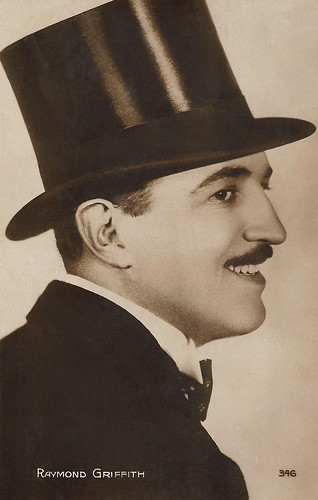
French postcard by Editions Cinémagazine, no. 346.
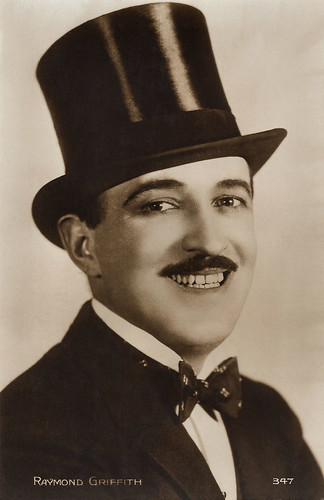
French postcard by Editions Cinémagazine, no. 347.
Raymond Griffith (1895-1957) was an American silent movie comedian, known for films such as Paths to Paradise (1925) and Hands Up! (1926). In the sound era, he worked as production supervisor and associate producer.
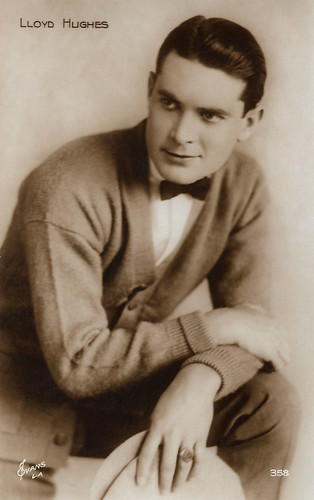
French postcard by Cinémagazine-Edition, no. 358. Photo: Evans, L.A.
Clean-cut, sensitive Lloyd Hughes (1897-1958) was an American actor of both the silent and sound film eras. He appeared in such silent classics as Tess of the Storm Country (1921), The Sea Hawk (1924), and The Lost World (1925).
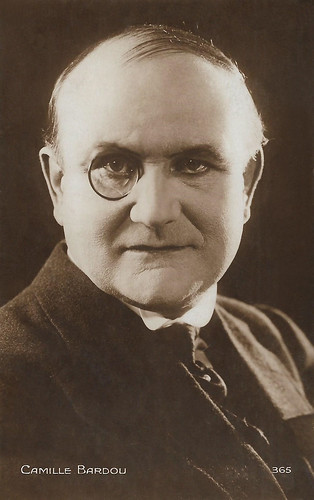
French postcard by Editions Cinémagazine, no. 365.
Camille Bardou (1872-1941) was a French stage and screen actor, who acted in cinema between 1904 and 1934.
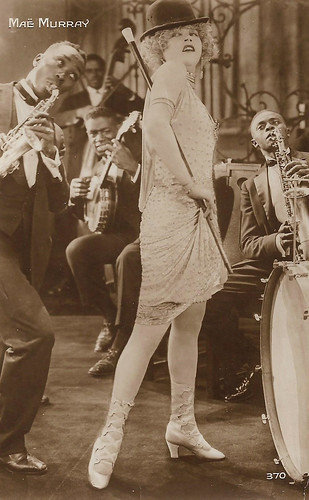
French postcard by Editions Cinémagazine, no. 370. Mae Murray in Circe the Enchantress (Robert Z. Leonard, 1924).
American actress and dancer Mae Murray (1885-1965) had her breakthrough on Broadway at the Ziegfeld Follies. Her film debut was in To Have and to Hold (1916). Murray became one of the biggest stars of Universal, often directed by her then-husband, Robert Z. Leonard. At the height of her career, she decided to found her own company with director John Stahl. While the films were successful, critics didn’t like them, because of her exaggerated emotions and her costumes. In the early 1920s, Murray started acting at Metro (later MGM). Murray’s most famous role was that in Erich Von Stroheim’s The Merry Widow (1925), co-starring John Gilbert.
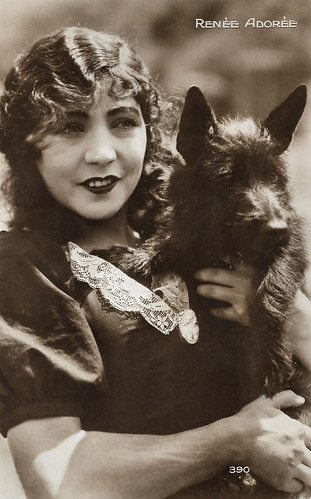
French postcard by Editions Cinémagazine, no. 390. Renée Adorée in The Flaming Forest (Reginald Barker, 1926).
French actress Renée Adorée (1898-1933) appeared in Hollywood in several silent films during the 1920s. She became famous as Melisande in the melodramatic romance and war epic The Big Parade (King Vidor, 1925) opposite John Gilbert. It became one of MGM's all-time biggest hits and is one of the classics of the silent film era. In The Mating Call (1928), produced by Howard Hughes, Adorée had a brief nude swimming scene that caused quite some commotion at the time. With the advent of sound in film, Adorée's voice met the film industry's new needs. But in 1930 she was diagnosed with tuberculosis and died in 1933, just a few days after her 35th birthday.
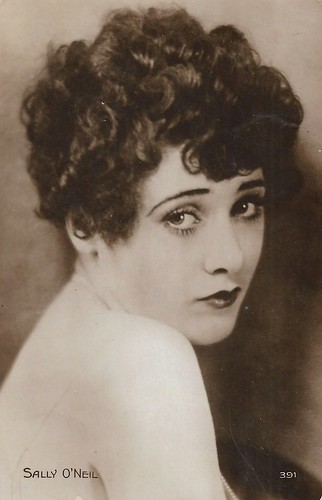
French postcard by Editions Cinémagazine, no. 391.
Cute and petite American actress Sally O'Neill (1908–1968) acted in almost 50 films between the mid-1920s and the mid-1930s.
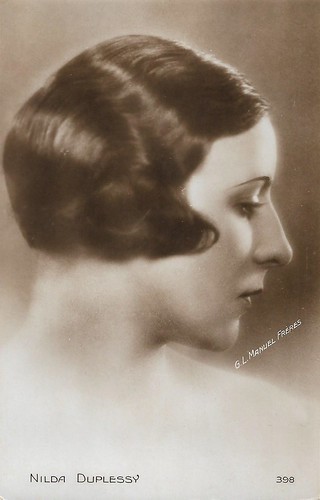
French postcard by Editions Cinémagazine, no. 398. Photo: G.L. Manuel Frères.
When Nilda Duplessy entered the film sets in 1922, she had already been a Parisian stage actress for a while, notably in revues by Rip at the theatres Capucines, Femina, and Vaudeville, while she could be seen in Le Bel Ange vint at the Theatre Michel and in Le Tracassin at the Potinière. Remarking her fine beauty, film director Gaston Roudès selected here for Le petit Moineau de Paris (1923), starring Régine Bouet. Not convinced herself, she returned to the stage. Robert Boudrioz called her back to the sets for the more substantial role of Marina de Dasetta opposite Sylvio De Pedrelli in L'Epervier (1925).
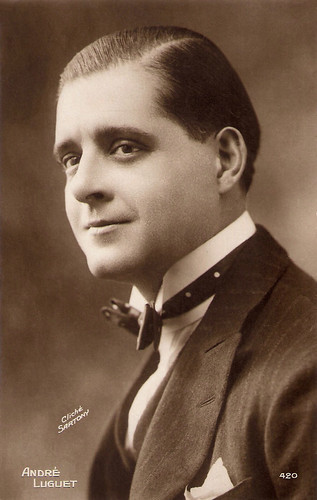
French postcard by Cinémagazine-Édition, no. 420. Photo: Sartony.
André Luguet (1892-1979) was a French stage and film actor. He appeared in over 120 films between 1910 and 1970, both in France and Hollywood.
Next Saturday, Part 2.

French postcard by Cinémagazine-Edition, Paris, no. 14.
Pearl White (1889-1938) was dubbed 'Queen of the Serials", and noted for doing her own stunts, in silent film serials such as The Perils of Pauline (1914) and The Exploits of Elaine (1914-15). Many episodes ended with a literal cliffhanger. In Europe, The Exploits of Elaine were re-edited with two subsequent serials into Les Mystères de New York. Until the end of the First World War, White remained globally a popular action heroine.

French postcard by Cinémagazine-Edition, Paris, no. 30.
Alla Nazimova (1879–1945) was a grand, highly flamboyant star of the American silent cinema. The Russian-born film and theatre actress, screenwriter, and film producer was widely known as just Nazimova. On Broadway, she was noted for her work in the classic plays of Ibsen, Chekhov, and Turgenev. Her efforts at silent film production were less successful, but a few sound-film performances survive as a record of her art.

French postcard by Cinémagazine-Edition, Paris, no. 71. Photo: Studio Rahma.
Gabriel de Gravone aka Gabriel de Gravonne (1887-1972) was an actor of French silent cinema. He is most known as Élie, the son of Sisif (Séverin-Mars) in Abel Gance’s La Roue (1920-1923).

French postcard by Cinémagazine-Edition, Paris, no. 87.
Betty Compson (1897–1974) was an American actress and film producer. She peaked in silent cinema and early talkies, and is best known for her performances as a suicidal prostitute rescued by a stoker (George Bancroft) in The Docks of New York (Joseph Von Sternberg, 1928), and as the manipulative carnival girl Carrie in the part-talkie The Barker (George Fitzmaurice, 1928), the latter earning a nomination for the Academy Award for Best Actress.

French postcard by Cinémagazine-Edition, Paris, no. 89.
Marion Davies (1897-1961) was one of the great comedic actresses of the silent era. She starred in nearly four dozen films between 1917 and 1937.

French postcard by Cinémagazine-Edition, Paris, no. 119. Photo: Sartony.
Georges Vaultier (1885-1926) was a French film actor, known for such films as Koenigsmark (1923), L'enfant roi (1923), Auf Befehl der Pompadour (1924), and Le fantôme du Moulin-Rouge (1925).

French postcard by Editions Cinémagazine, no. 126. John Barrymore in Sherlock Holmes (Albert Parker, 1922).
John Barrymore (1882-1942) was an American stage and screen actor whose rise to superstardom and subsequent decline is one of the legendary tragedies of Hollywood. A member of the most famous generation of the most famous theatrical family in America, he was also its most acclaimed star. He excelled in high drama, in productions of 'Justice' (1916), 'Richard III' (1920) and 'Hamlet' (1922). After a success as Hamlet in London in 1925, Barrymore left the stage for 14 years and instead focused entirely on films.

French postcard by Cinémagazine-Edition, Paris, no. 137.
Lila Lee (1901–1973) was a prominent screen actress, primarily a leading lady, of the silent film and early sound film eras.

French postcard by Editions Cinémagazine, no. 142. Photo: P. Apers.
Elegant French actress Arlette Marchal (1902-1984) started as a fashion model and from the 1950s on she dedicated herself mostly to her fashion enterprise. Between 1922 and 1951 she starred in 41 European and American films.

French postcard by Editions Cinémagazine, no. 163.
American actress Bessie Love (1898-1986) was introduced to the cinema by D.W. Griffith. He also gave the actress her screen name. She played innocent young girls and wholesome leading ladies in silent films and early talkies. Her acting career spanned eight decades, and her role in The Broadway Melody (1929) earned her a nomination for the Oscar for Best Actress.

French postcard by Cinémagazine-Edition, Paris, no. 170. Caption: The Gish sisters (Lilian and Dorothy).
American actress Dorothy Gish (1898-1968) and her sister Lilian Gish (1893-1993) were both popular Hollywood stars of the silent era. D.W. Griffith discovered the two girls in 1912 and they starred in his epics Hearts of the World (1918) and Orphans of the Storm (1921).

French postcard by Cinémagazine-Edition, no. 183.
American film actor Tom Mix (1880–1940) was the star of many early Westerns between 1909 and 1935. Mix appeared in 291 films, all but nine of which were silent movies. He was Hollywood's first Western megastar and helped to define the genre for all cowboy actors who followed.

French postcard by Cinémagazine-Edition, no. 189. Vanni Marcoux as Charles le Téméraire (Charles the Bold) in the French silent film Le Miracle des Loups (Raymond Bernard, 1924).
Jean-Émile Diogène Marcoux (1877–1962) was a French operatic bass-baritone, known professionally as Vanni Marcoux (aka Vanni-Marcoux), and renown as one of the most memorable singing-actors of the 20th century. Vanni Marcoux only acted in 4 films, but these were leads as Faust in Don Juan et Faust (Marcel L'Herbier, 1922), as Maurice Ferrioul in the Franco-British coproduction The Scandal (Arthur Rooke, 1923), as Charles le Téméraire in Le Miracle des Loups (Raymond Bernard, 1924), and as Vitalis in Sans famille (Marc Allégret, 1934).

French postcard by Cinémagazine-Edition, Paris, no. 218.
American silent film actress Betty Blythe (1893-1972) was a brunette, buxom matinee idol. She capitalised on the 'roaring 1920s' infatuation with exotic screen sirens to achieve a brief period of stardom. Betty was notorious as one of the first actresses to appear (semi-)nude on screen in The Queen of Sheba (1922). Over the course of her career, she acted in 63 silent and 56 sound films.

French postcard by Cinémagazine-Edition, no. 228. Photo: Gene Kornman.
American actor, comedian, director, producer, screenwriter, and stunt performer Harold Lloyd (1893-1971) is best known for his silent comedies. He ranks alongside Charlie Chaplin and Buster Keaton as one of the three most popular and influential comedians of the silent film. Between 1914 and 1947, Lloyd made nearly 200 comedies, often as a bespectacled 'Glass' character, a resourceful, success-seeking go-getter who was perfectly in tune with 1920s-era United States. His films frequently contained 'thrill sequences' of extended chase scenes and daredevil physical feats. A classic is Lloyd hanging from the hands of a clock high above the street in Safety Last! (1923).

French postcard by Editions Cinémagazine, no. 261. Louise Fazenda was called in France Philomène.
Louise Fazenda (1895-1962) was a gawky, highly popular funny girl in slapstick comedies for Keystone Studios. She paired up well with comedian Charlie Murray. Her best-known character was her country bumpkin - complete with spit curls, multiple pigtails, and calico dresses. In the early 1920s, Louise left Mack Sennett's company and progressed to feature films, where her eccentric talents were greatly utilised in musicals and knockabout comedies.

French postcard by Cinémagazine-Edition, no. 269. Photo: Balazs.
Sturdy and blond Henny Porten (1890-1960) was one of Germany's most important and popular film actresses of the silent cinema. She became the quintessence of German womanhood, ladylike yet kindhearted and a not a little petit bourgeois. She was also the producer of many of her own films.

French postcard by Cinémagazine-Edition, no. 280.
Alma Bennett (1904-1958) was an American film actress of the silent era, who appeared in 64 films between 1915 and 1931.

French postcard by Cinémagazine-Edition, no. 281.
Suave and debonair American actor Adolphe Menjou (1890-1963) with his trademark waxy black mustache was one of Hollywood's most distinguished stars and one of America's 'Best Dressed Men'. He started as a matinée idol in the silent cinema in such classics as Ernst Lubitsch's The Marriage Circle (1924). His sound films included Morocco (1931) with Marlene Dietrich and Gary Cooper, A Star is Born (1937), and Stanley Kubrick's Paths of Glory (1957) with Kirk Douglas. In 1931, he was nominated for an Oscar for The Front Page (1931).

French postcard by Cinémagazine-Edition, no. 283. Photo: Paramount. Greta Nissen in The Wanderer (Raoul Walsh, 1925).
Blonde Norwegian-American bombshell Greta Nissen (1906-1988) is mostly remembered for a role she didn't play; or, rather, a role that was eventually re-filmed with someone else.

French postcard by Cinémagazine-Edition, no. 284.
American actor Conrad Nagel (1897-1970) was a tall, blue-eyed matinee idol of the 1920s. He successfully made the transition to sound film.

French postcard by Cinémagazine-Edition, Paris, no. 286.
Polish film actress Pola Negri (1897-1987) achieved fame and notoriety as a femme fatale in German and American silent films between the 1910s and 1930s. Negri was an overnight sensation in Ernst Lubitsch' Madame du Barry/Passion (1919). She moved to Hollywood where she lived in a palace, modeled after the White House.

French postcard by Cinémagazine-Edition, Paris, no. 288.
Estelle Taylor (1894–1958) was an American actress, singer, model, and animal rights activist. With her "dark-brown, almost black hair, and brown eyes", she was regarded as one of the most beautiful silent film stars of the 1920s.

French postcard by Cinémagazine-Edition, no. 296. Photo: Evans Studio, L.A.
Enid Bennett (1893-1969) was an Australian-born silent film actress, mostly active in the American cinema. She peaked in the late 1910s and early 1920s with films such as Robin Hood (1922), starring Douglas Fairbanks, and The Sea Hawk (1924). In the sound era, she played Jackie Coogan's mother in the Oscar-winning film Skippy (1931). She was the wife of director Fred Niblo and after his death of director Sidney Franklin.

French postcard by Editions Cinémagazine, no. 301.
American actor Wallace Beery (1885-1949) is best known for his portrayal of Bill in Min and Bill opposite Marie Dressler, as Long John Silver in Treasure Island, as Pancho Villa in Viva Villa!, and his titular role in The Champ, for which he won the Academy Award for Best Actor. Beery appeared in some 250 films in a 36-year career. He was the brother of actor Noah Beery, Sr. and uncle of actor Noah Beery, Jr.

French postcard by Editions Cinémagazine, no. 325. Photo: Studio G.L. Manuel Frères.
French actress Dolly Davis (1896-1962) was a very popular comédienne in the 1920s, who was often paired with her then companion André Roanne. They even starred together in a film simply called Dolly (Pierre Colombier, 1928).

French postcard by Cinémagazine-Edition, Paris, no. 331.
American film actor Richard Dix (1893–1949) achieved popularity in both silent and sound film, first as the rugged and stalwart hero in countless Westerns, then dramatic features such as Cecil B. DeMille's The Ten Commandments (1923). After his years of silent film at Paramount, and thanks to his deep voice and commanding presence, he became a well-known star at RKO in the 1930s. He was nominated for the Academy Award for Best Actor for his lead role in the Best Picture-winning epic, Cimarron (1931).

French postcard by Editions Cinémagazine, no. 332. NB Costello's first name is misspelled on the postcard.
American film actress Dolores Costello (1903-1979) was 'The Goddess of the Silent Screen'. She was Hollywood royalty: the daughter of popular matinee idol Maurice Costello, wife of John Barrymore and grandmother of Drew Barrymore.

French postcard by Editions Cinémagazine, no. 339. Photo: Studio G.L. Manuel Frères.
Spanish actress, singer, and diva Raquel Meller acted mainly in French silent films. She was already a highly popular singer before debuting as a film actress in 1919.

French postcard by Editions Cinémagazine, no. 341.
Suave, dark-haired Ricardo Cortez, born Jacob Krantz or Kranze (1900-1977) was an American screen actor and director, who peaked in the 1920s as Paramount's romantic lover opposite the big female stars of the decade, while in the 1930s he rather played tough men such as the first Sam Spade on the screen.

French postcard by Editions Cinémagazine, no. 346.

French postcard by Editions Cinémagazine, no. 347.
Raymond Griffith (1895-1957) was an American silent movie comedian, known for films such as Paths to Paradise (1925) and Hands Up! (1926). In the sound era, he worked as production supervisor and associate producer.

French postcard by Cinémagazine-Edition, no. 358. Photo: Evans, L.A.
Clean-cut, sensitive Lloyd Hughes (1897-1958) was an American actor of both the silent and sound film eras. He appeared in such silent classics as Tess of the Storm Country (1921), The Sea Hawk (1924), and The Lost World (1925).

French postcard by Editions Cinémagazine, no. 365.
Camille Bardou (1872-1941) was a French stage and screen actor, who acted in cinema between 1904 and 1934.

French postcard by Editions Cinémagazine, no. 370. Mae Murray in Circe the Enchantress (Robert Z. Leonard, 1924).
American actress and dancer Mae Murray (1885-1965) had her breakthrough on Broadway at the Ziegfeld Follies. Her film debut was in To Have and to Hold (1916). Murray became one of the biggest stars of Universal, often directed by her then-husband, Robert Z. Leonard. At the height of her career, she decided to found her own company with director John Stahl. While the films were successful, critics didn’t like them, because of her exaggerated emotions and her costumes. In the early 1920s, Murray started acting at Metro (later MGM). Murray’s most famous role was that in Erich Von Stroheim’s The Merry Widow (1925), co-starring John Gilbert.

French postcard by Editions Cinémagazine, no. 390. Renée Adorée in The Flaming Forest (Reginald Barker, 1926).
French actress Renée Adorée (1898-1933) appeared in Hollywood in several silent films during the 1920s. She became famous as Melisande in the melodramatic romance and war epic The Big Parade (King Vidor, 1925) opposite John Gilbert. It became one of MGM's all-time biggest hits and is one of the classics of the silent film era. In The Mating Call (1928), produced by Howard Hughes, Adorée had a brief nude swimming scene that caused quite some commotion at the time. With the advent of sound in film, Adorée's voice met the film industry's new needs. But in 1930 she was diagnosed with tuberculosis and died in 1933, just a few days after her 35th birthday.

French postcard by Editions Cinémagazine, no. 391.
Cute and petite American actress Sally O'Neill (1908–1968) acted in almost 50 films between the mid-1920s and the mid-1930s.

French postcard by Editions Cinémagazine, no. 398. Photo: G.L. Manuel Frères.
When Nilda Duplessy entered the film sets in 1922, she had already been a Parisian stage actress for a while, notably in revues by Rip at the theatres Capucines, Femina, and Vaudeville, while she could be seen in Le Bel Ange vint at the Theatre Michel and in Le Tracassin at the Potinière. Remarking her fine beauty, film director Gaston Roudès selected here for Le petit Moineau de Paris (1923), starring Régine Bouet. Not convinced herself, she returned to the stage. Robert Boudrioz called her back to the sets for the more substantial role of Marina de Dasetta opposite Sylvio De Pedrelli in L'Epervier (1925).

French postcard by Cinémagazine-Édition, no. 420. Photo: Sartony.
André Luguet (1892-1979) was a French stage and film actor. He appeared in over 120 films between 1910 and 1970, both in France and Hollywood.
Next Saturday, Part 2.
Published on October 23, 2020 22:00
October 22, 2020
Directed by Friedrich Zelnik
Film director, producer, and actor Friedrich Zelnik or Frederic Zelnik (1885-1950) was Austrian, but he directed two of the most popular Dutch films of the 1930s. He was initially an actor, who became one of the most important producers-directors of the German silent cinema. During the 1920s he had his greatest successes as director-producer of operetta style costume films starring his wife, Lya Mara. A critical success was his drama Die Weber/The Weaver (1927). After 1933, he worked in Great-Britain and in the Netherlands.

German postcard by Photochemie, no. K. 234. Photo: Alex Binder, Berlin.
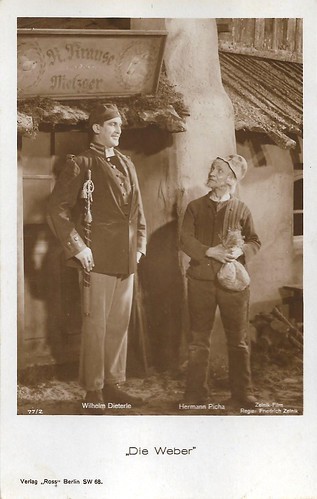
German postcard by Ross Verlag, Berlin, no. 77/2 Photo: Zelnik-Film. Wilhelm Dieterle and Hermann Picha in Die Weber/The Weavers (Friedrich Zelnik, 1927).
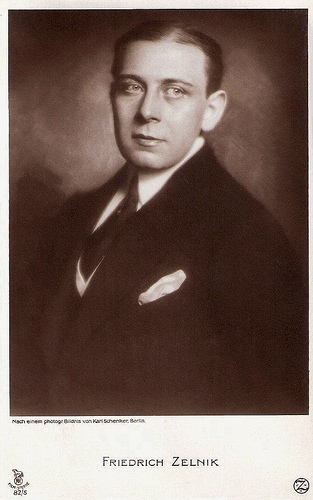
German postcard by Rotophot in the Film Sterne series, no. 82/5. Photo: Karl Schenker, Berlin.
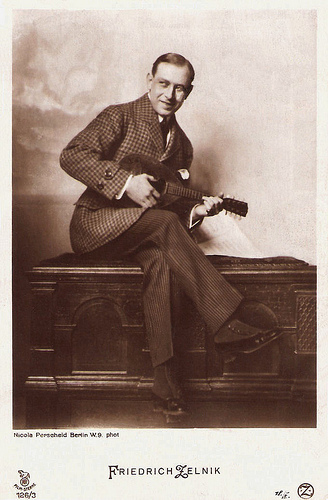
German postcard by Rotophot in the Film Sterne series, no. 126/3. Photo: Nicola Perscheid, Berlin.
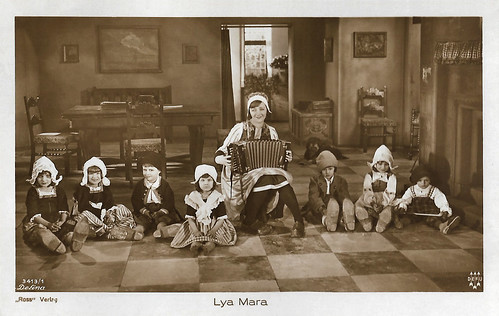
German postcard by Ross Verlag, no. 3413/1. Photo: Defina / Defu. Lya Mara in Heut tanzt Mariett/Marietta (Friedrich Zelnik, 1928).
Messter
Friedrich Zelnik was born in 1885 in a Jewish family in Czernowitz, then the capital of the Duchy of Bukovina in the Austrian part of the Austro-Hungarian Monarchy (today Chernivtsi, Ukraine). Czernowitz was largely populated by Jews. After Wilno it was the most important city for the Jewish culture in Eastern Europe.
Zelnik studied law in Vienna, but then worked as an actor in theatres in Nürnberg, Aachen, Worms, Prague and finally Berlin, where he appeared in Theater an der Königsgrätzer Straße, Berliner Theater and Komödienhaus.
In 1910 he began to act in short silent films for Messters Projektion GmbH, such as Verkannt/Misunderstood (N.N., 1910), Japanisches Opfer/Japanese victims (Adolf Gärtner, 1910) with Max Mack, and Im Glück vergessen/Forget the luck (Adolf Gärtner, 1911) with silent superstar Henny Porten .
For another company, he played the lead in Europäisches Sklavenleben/European slave life (Emil Justitz, 1912). These films made him one of the first German film stars.
Then there was an interval in his film career of three years during which Zelnik set up his own production company, Berliner Film-Manukfaktur, together with Walter Behrend and Max Liebenau.
In 1915, he started to produce and direct films while he still also played parts in other directors’ films. Among these films were the Sherlock Holmes mystery Das dunkle Schloß/The Hound of the Baskervilles: The Dark Castle (Willy Zeyn, 1915) starring Eugen Burg as Holmes, Arme Maria/Poor Mary (Willy Zeyn, Max Mack, 1915) featuring Hanni Weisse , and Die Fiebersonate/The Fever Sonata (Emmerich Hanus, 1916) with Lotte Neumann .
This latter film he also produced. Other early productions were Ein Zirkusmädel/A Circus Girl (Carl Wilhelm, 1917) with Lisa Weise , and the Charles Dickens adaptation Klein Doortje/Little Dorrit (Friedrich Zelnik, 1917).

German postcard by Verlag Ross, no. 357/2. Photo: Hanna Holdt, München. Perhaps this card refers to the film Klein Doortje/Little Dorit (Friedrich Zelnik, 1917), starring Lisa Weise , which takes place in the Netherlands.
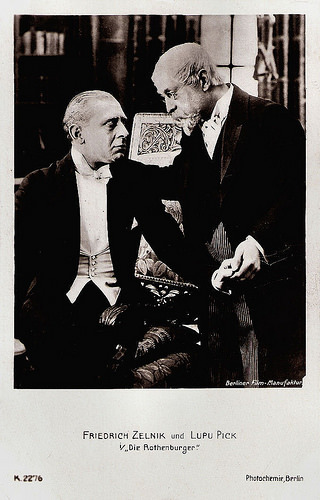
German postcard by Photochemie, Berlin, no. K. 2276. Photo: Berliner Film-Manufaktur. Friedrich Zelnik and Lupu Pick in Die Rothenburger/The Rothenburgers (Lupu Pick, 1918).
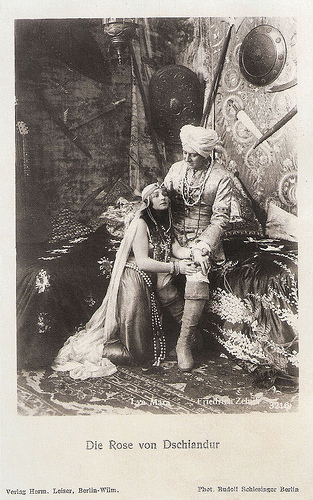
German postcard by Verlag Hermann Leiser, Berlin-Wilm, no. 3216. Photo: Rudolph Schlesinger. Friedrich Zelnik and Lya Mara in Die Rose von Dschiandur/The Rose of Dschiandur (Alfred Halm, 1918).
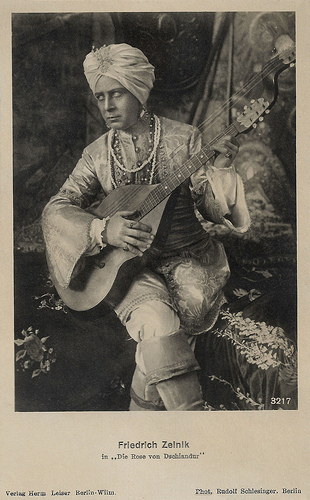
German postcard by Verlag Hermann Leiser, Berlin-Wilm, no. 3217. Photo: Rudolph Schlesinger. Friedrich Zelnik in Die Rose von Dschiandur/The Rose of Dschiandur (Alfred Halm, 1918).
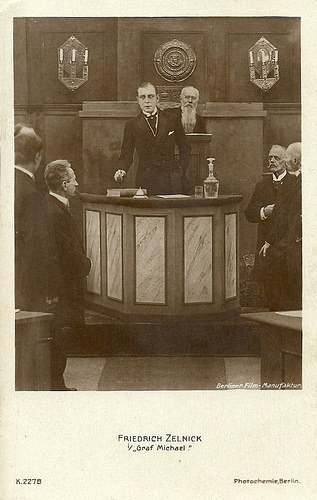
German postcard by Photochemie, Berlin, no. K. 2278. Photo: Berliner Film-Manufaktur. Friedrich Zelnik in Graf Michael/Count Michael (Alfred Halm, 1918). Collection: Didier Hanson.
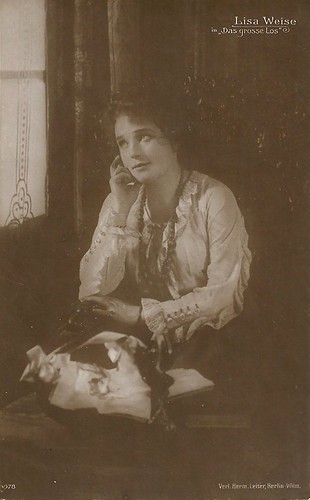
German postcard by Verlag Hermann Leiser, Berlin-Wilm., no. 5448. Photo: Berliner Film-Manufaktur. Lisa Weise in Das grosse Los/The big prize (Friedrich Zelnik, 1917).
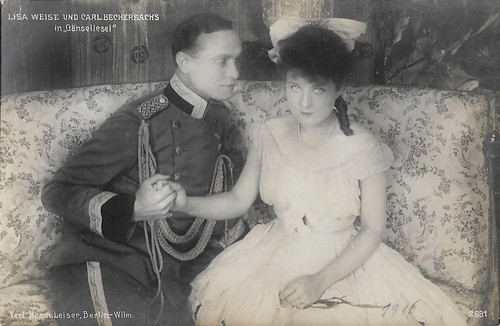
German postcard by Verlag Hermann Leiser, no 2681. Photo: Berliner Film-Manufaktur. Lisa Weise and Karl Beckersachs in Gänseliesel (Friedrich Zelnik, 1918).
Among the Greatest Box Office Hits
In 1918, Friedrich Zelnik met in Warsaw a young Polish ballet dancer turned film actress named Lya Mara . They married and he started to produce and direct films for her. He made Mara a huge star of the German cinema.
Between 1917 and 1922, the Berliner Film-Manukfaktur produced more than 120 films. From 1920 on, Zelnik's companies ran under several names: Zelnik-Mara-Film GmbH, Friedrich Zelnik-film GmbH, and Efzet-Film GmbH. Zelnik-Mara-Film GmbH produced silent entertainment films in which Mara was the female star.
Together they made very popular, operetta style costume films like An der schönen blauen Donau/The Beautiful Blue Danube (Friedrich Zelnik, 1926) with Harry Liedtke , Die Försterchristl/The Bohemian Dancer (Friedrich Zelnik, 1926) again with Liedtke, Das Tanzende Wien/Dancing Vienna (Friedrich Zelnik, 1927), and Heut' tanzt Mariett/Marietta (Friedrich Zelnik, 1928) with Fred Louis Lerch .
These films brought Lya Mara and Zelnik enormous success in Germany and beyond. Filmportal.de : ”Zelnik's sentimental costume dramas (…) always ranked among the greatest box office hits of their respective season. Nevertheless, his film version of Gerhart Hauptmann's Die Weber/The Weaver (Friedrich Zelnik, 1927) became popular even with ‘progressive’ critics. To this day, this rather untypical film for Zelnik still mainly accounts for his reputation as a filmmaker.”
Several of his collaborators, including cameraman Frederik Fuglsang and production designer André Andrejew, are perceived today as notable artists of the German silent cinema. Another important collaborator was scriptwriter Fanny Carlsen.
Busy with directing and producing these films, Zelnik did not find the time to appear himself in films anymore. His last film appearance was in Das Geheimnis der alten Mamsell/The Story of the Old Mademoiselle (Paul Merzbach, 1925) starring Marcella Albani .
In 1925, Zelnik was head of the production at Deutsche Fox for six films, and in 1926 he became a board member and the art director of Defu (Deutsche Film Union AG) and Defina (Deutsche First National Pictures GmbH).
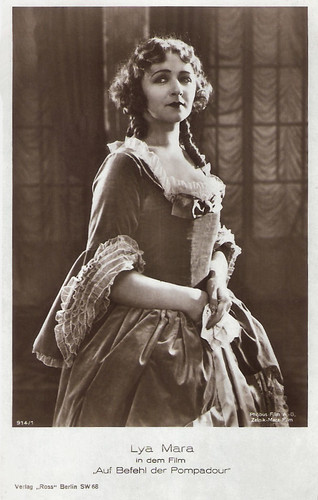
German postcard by Ross Verlag, no. 914/1, 1925-1926. Photo: Phoebus Film / Zelnik-Mara Film. Lya Mara in Auf Befehl der Pompadour/By Order of Pompadour (Friedrich Zelnik, 1924).
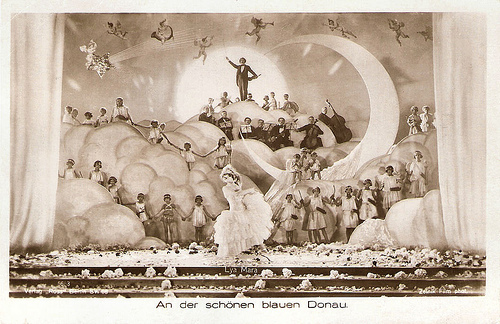
German postcard by Ross Verlag, no. 56/3, 1925-1926. Photo: Zelnik Film. Publicity still for An der schönen blauen Donau/The Beautiful Blue Danube (Friedrich Zelnik, 1926) with Lya Mara . Collection: Geoffrey Donaldson Institute.
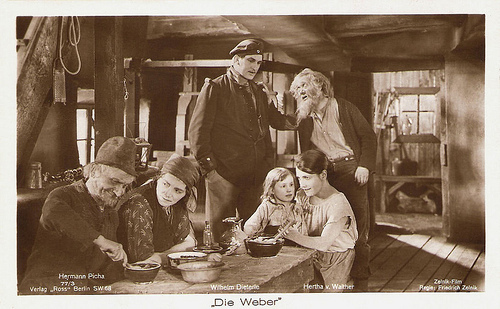
German postcard by Ross Verlag, Berlin, no. 77/3. Photo: Zelnik-Film. Hermann Picha , Wilhelm Dieterle and Hertha von Walther in Die Weber (Friedrich Zelnik, 1927).
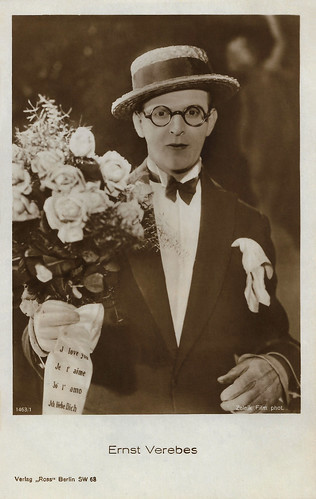
German postcard by Ross Verlag, no. 1463/1, 1927-1928. Photo: Zelnik Film. Ernst (or Ernö) Verebes in Der Veilchenfresser/The violet eater (Friedrich Zelnik, 1926).
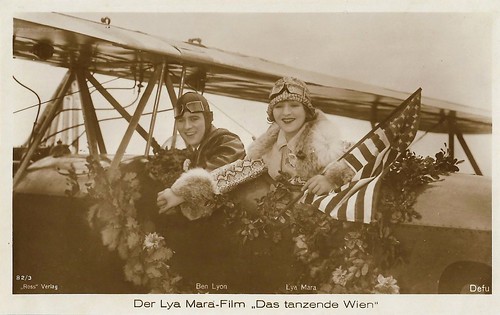
German postcard by Ross Verlag, no. 82/3. Photo: Defu. Lya Mara and Ben Lyon in Das tanzende Wien/Dancing Vienna (Friedrich Zelnik, 1927).
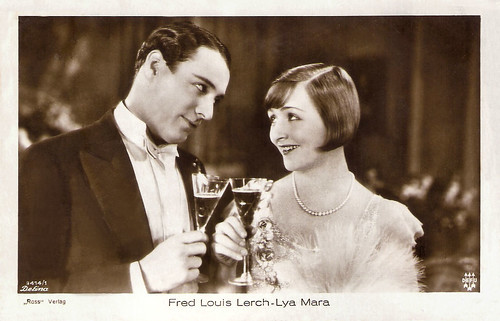
German postcard by Ross Verlag, no. 3414/1, 1928-1929. Photo: Defina / DEFU. Fred Louis Lerch and Lya Mara in Heut tanzt Mariett/Today dances Mariett (Friedrich Zelnik, 1928). Collection: Geoffrey Donaldson Institute.
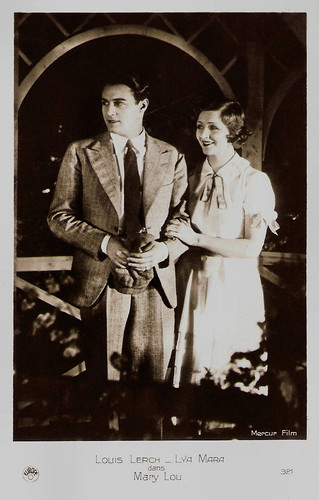
French postcard by Europe, no. 321. Photo: Mercur Film. Fred Louis Lerch and Lya Mara in Mary Lou (Friedrich Zelnik, 1928).
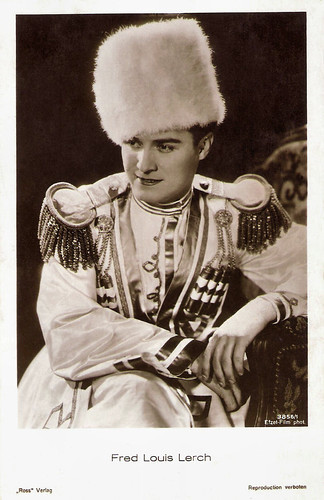
German postcard by Ross Verlag, no. 3856/1, 1928-1929. Photo: Efzet-Film. Fred Louis Lerch in Der rote Kreis/The Crimson Circle (Friedrich Zelnik, 1929).
Hollywood
Upon the introduction of sound film, Friedrich Zelnik became the first director in Europe to post synchronise a film, the Edgar Wallace adaptation Der rote Kreis/The Crimson Circle (Friedrich Zelnik, 1929) starring Lya Mara and Stewart Rome . In London, he used the DeForest Phonofilm sound-on-film process and added music by Edmund Meisel.
In 1930, the Friedrich Zelnik-Film GmbH went into liquidation and Zelnik travelled to Hollywood, California. Upon his return, he directed his first full sound film, a new version of his silent success Die Försterchristl/The Bohemian Girl (Friedrich Zelnik, 1931) featuring Irene Eisinger.
He had no problems adapting his operetta style to the sound film, and soon more musicals like Walzerparadies/Waltz Paradise (Friedrich Zelnik, 1931) with Charlotte Susa , Jeder fragt nach Erika/Everyone asks for Erika (Friedrich Zelnik, 1931) with Lya Mara in her only sound film role, and Spione im Savoy-Hotel/The Gala Performance (Friedrich Zelnik, 1932) with Alfred Abel .
After Adolph Hitler took power in 1933, Zelnik and Lya Mara left Germany for London. His first British film was the musical comedy Happy (Friedrich Zelnik, 1933) with Stanley Lupino. It was an English remake of Es war einmal ein Musikus/There was once a musician (Friedrich Zelnik, 1933), the last film he had made in Germany.
In the years to follow Zelnik, now Frederic (or Fred) Zelnik, continued to direct and produce films in Great Britain and The Netherlands. Among his British films are the musicals Southern Roses ( Frederic Zelnik, 1934), The Lilac Domino (Frederic Zelnik, 1937) with S.Z. Szakall in a supporting part, and I Killed the Count (Frederic Zelnik, 1939) starring Ben Lyon.
In the Netherlands, he directed Vadertje Langbeen/Daddy Long Legs (Friedrich Zelnik, 1938) based on the popular and often filmed novel by Jean Webster, and Morgen gaat ’t beter!/Tomorrow It Will Be Better (Friedrich Zelnik, 1939). Both films were produced by German émigré producer and distributor Rudolf Meyer, and starred Dutch actress Lily Bouwmeester .
Zelnik took British citizenship. After 1940 he only worked as a producer, in cooperation with British National. His later work included the musical Give Me the Stars (Maclean Rogers, 1945) and the British-Italian drama The Glass Mountain (Henry Cass, 1949) with Michael Denison and Valentina Cortese .
Together with Raymond Stross, he founded Zelstro Films to produce the film Hell Is Sold Out (Michael Anderson, 1951) but Zelnik did not live to see its completion. Friedrich Zelnik died in 1950 in London. He was 65.
About what happened to his wife, Lya Mara , there is only a rumour that she died in 1960 in Switzerland.
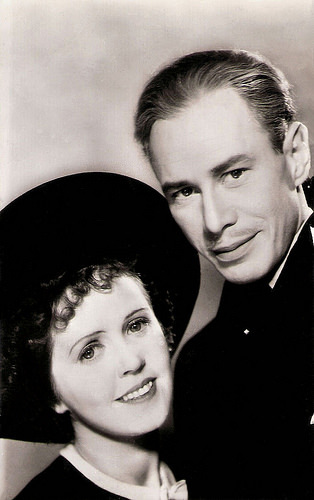
Dutch promotion card by Cinema Odeon, Den Haag. Photo: Neerlandia. Publicity still for Vadertje Langbeen/Daddy Longlegs (Friedrich Zelnik, 1938) with Lily Bouwmeester as Judy and Paul Storm as Vadertje Langbeen.
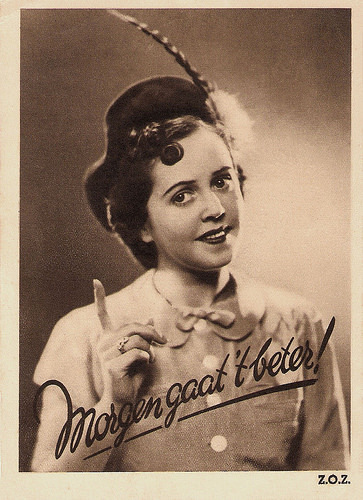
Dutch postcard by Colosseum Theater, Rotterdam. Photo: Neerlandia-Filmex. Publicity still for Morgen gaat het beter/Tomorrow It Will Be Better (Friedrich Zelnik, 1939) with Lily Bouwmeester .
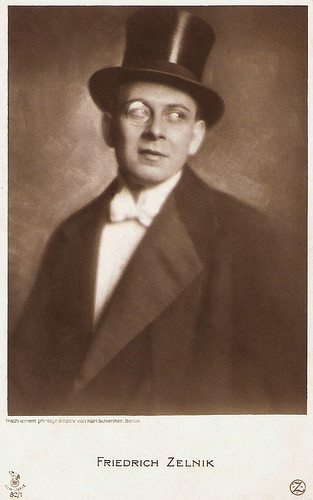
German postcard by Rotophot in the Film Sterne Series, Berlin, no. 82/1. Photo: Karl Schenker, Berlin.
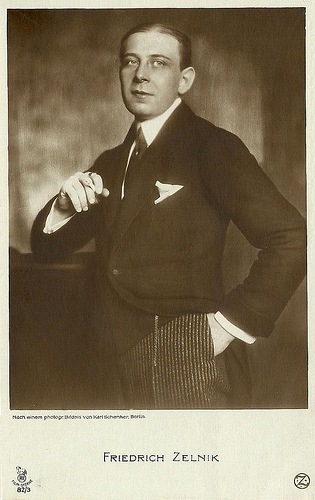
German postcard by Rotophot in the Film Sterne Series, Berlin, no. 82/3. Photo: Karl Schenker, Berlin. Collection: Didier Hanson.
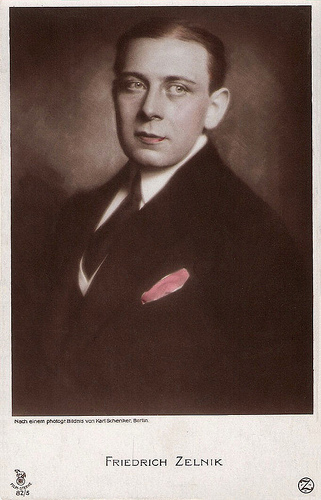
German postcard by Rotophot in the Film Sterne series, no. 82/5. Photo: Karl Schenker, Berlin.
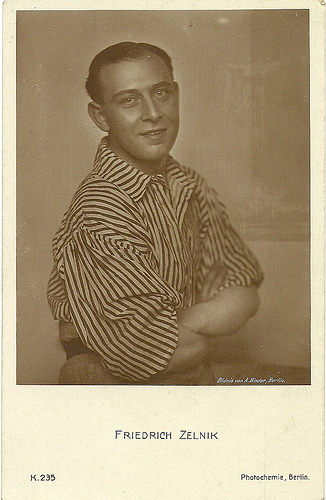
German postcard by Photochemie, Berlin, no. K. 235. Photo: Alex Binder, Berlin. Collection: Didier Hanson.
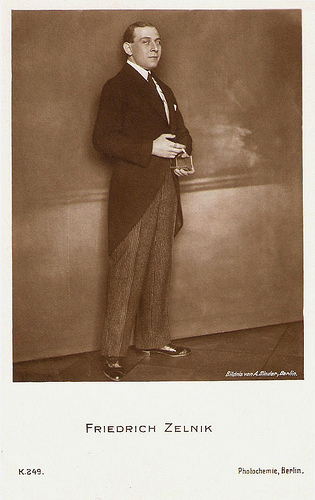
German postcard by Photochemie, Berlin, no. K. 249. Photo: Alex Binder, Berlin.
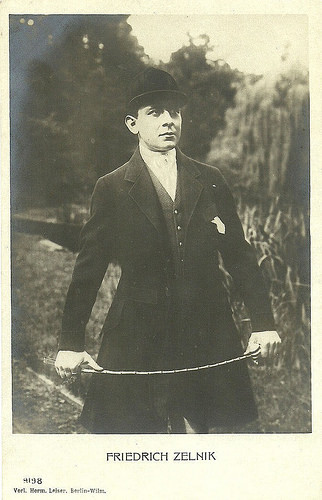
German postcard by Verlag Hermann Leiser, Berlin-Wilm., no. 3198 (?). Collection: Didier Hanson.
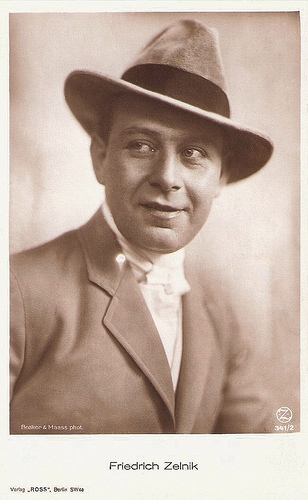
German postcard by Ross Verlag, no. 341/2, 1919-1924. Photo: Becker & Maass Phot.
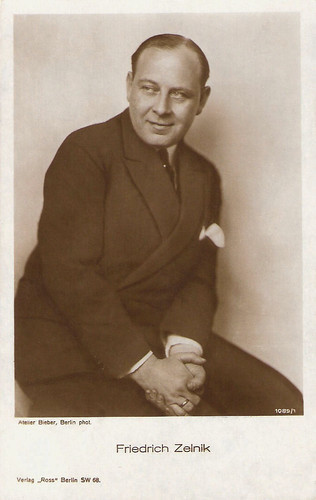 German postcard by Ross Verlag, no. 1089/1, 1927-1928. Photo: Atelier Bieber, Berlin.
German postcard by Ross Verlag, no. 1089/1, 1927-1928. Photo: Atelier Bieber, Berlin.
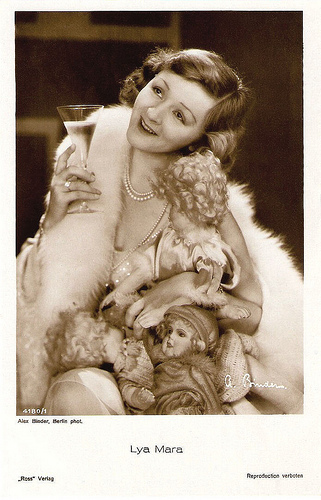
Lya Mara . German postcard by Ross Verlag, no. 4180/1, 1929-1930. Photo: Alex Binder, Berlin.
Sources: Filmportal.de, Stephanie d'Heil (Steffi-Line.de), Wikipedia (English and Dutch), and

German postcard by Photochemie, no. K. 234. Photo: Alex Binder, Berlin.

German postcard by Ross Verlag, Berlin, no. 77/2 Photo: Zelnik-Film. Wilhelm Dieterle and Hermann Picha in Die Weber/The Weavers (Friedrich Zelnik, 1927).

German postcard by Rotophot in the Film Sterne series, no. 82/5. Photo: Karl Schenker, Berlin.

German postcard by Rotophot in the Film Sterne series, no. 126/3. Photo: Nicola Perscheid, Berlin.

German postcard by Ross Verlag, no. 3413/1. Photo: Defina / Defu. Lya Mara in Heut tanzt Mariett/Marietta (Friedrich Zelnik, 1928).
Messter
Friedrich Zelnik was born in 1885 in a Jewish family in Czernowitz, then the capital of the Duchy of Bukovina in the Austrian part of the Austro-Hungarian Monarchy (today Chernivtsi, Ukraine). Czernowitz was largely populated by Jews. After Wilno it was the most important city for the Jewish culture in Eastern Europe.
Zelnik studied law in Vienna, but then worked as an actor in theatres in Nürnberg, Aachen, Worms, Prague and finally Berlin, where he appeared in Theater an der Königsgrätzer Straße, Berliner Theater and Komödienhaus.
In 1910 he began to act in short silent films for Messters Projektion GmbH, such as Verkannt/Misunderstood (N.N., 1910), Japanisches Opfer/Japanese victims (Adolf Gärtner, 1910) with Max Mack, and Im Glück vergessen/Forget the luck (Adolf Gärtner, 1911) with silent superstar Henny Porten .
For another company, he played the lead in Europäisches Sklavenleben/European slave life (Emil Justitz, 1912). These films made him one of the first German film stars.
Then there was an interval in his film career of three years during which Zelnik set up his own production company, Berliner Film-Manukfaktur, together with Walter Behrend and Max Liebenau.
In 1915, he started to produce and direct films while he still also played parts in other directors’ films. Among these films were the Sherlock Holmes mystery Das dunkle Schloß/The Hound of the Baskervilles: The Dark Castle (Willy Zeyn, 1915) starring Eugen Burg as Holmes, Arme Maria/Poor Mary (Willy Zeyn, Max Mack, 1915) featuring Hanni Weisse , and Die Fiebersonate/The Fever Sonata (Emmerich Hanus, 1916) with Lotte Neumann .
This latter film he also produced. Other early productions were Ein Zirkusmädel/A Circus Girl (Carl Wilhelm, 1917) with Lisa Weise , and the Charles Dickens adaptation Klein Doortje/Little Dorrit (Friedrich Zelnik, 1917).

German postcard by Verlag Ross, no. 357/2. Photo: Hanna Holdt, München. Perhaps this card refers to the film Klein Doortje/Little Dorit (Friedrich Zelnik, 1917), starring Lisa Weise , which takes place in the Netherlands.

German postcard by Photochemie, Berlin, no. K. 2276. Photo: Berliner Film-Manufaktur. Friedrich Zelnik and Lupu Pick in Die Rothenburger/The Rothenburgers (Lupu Pick, 1918).

German postcard by Verlag Hermann Leiser, Berlin-Wilm, no. 3216. Photo: Rudolph Schlesinger. Friedrich Zelnik and Lya Mara in Die Rose von Dschiandur/The Rose of Dschiandur (Alfred Halm, 1918).

German postcard by Verlag Hermann Leiser, Berlin-Wilm, no. 3217. Photo: Rudolph Schlesinger. Friedrich Zelnik in Die Rose von Dschiandur/The Rose of Dschiandur (Alfred Halm, 1918).

German postcard by Photochemie, Berlin, no. K. 2278. Photo: Berliner Film-Manufaktur. Friedrich Zelnik in Graf Michael/Count Michael (Alfred Halm, 1918). Collection: Didier Hanson.

German postcard by Verlag Hermann Leiser, Berlin-Wilm., no. 5448. Photo: Berliner Film-Manufaktur. Lisa Weise in Das grosse Los/The big prize (Friedrich Zelnik, 1917).

German postcard by Verlag Hermann Leiser, no 2681. Photo: Berliner Film-Manufaktur. Lisa Weise and Karl Beckersachs in Gänseliesel (Friedrich Zelnik, 1918).
Among the Greatest Box Office Hits
In 1918, Friedrich Zelnik met in Warsaw a young Polish ballet dancer turned film actress named Lya Mara . They married and he started to produce and direct films for her. He made Mara a huge star of the German cinema.
Between 1917 and 1922, the Berliner Film-Manukfaktur produced more than 120 films. From 1920 on, Zelnik's companies ran under several names: Zelnik-Mara-Film GmbH, Friedrich Zelnik-film GmbH, and Efzet-Film GmbH. Zelnik-Mara-Film GmbH produced silent entertainment films in which Mara was the female star.
Together they made very popular, operetta style costume films like An der schönen blauen Donau/The Beautiful Blue Danube (Friedrich Zelnik, 1926) with Harry Liedtke , Die Försterchristl/The Bohemian Dancer (Friedrich Zelnik, 1926) again with Liedtke, Das Tanzende Wien/Dancing Vienna (Friedrich Zelnik, 1927), and Heut' tanzt Mariett/Marietta (Friedrich Zelnik, 1928) with Fred Louis Lerch .
These films brought Lya Mara and Zelnik enormous success in Germany and beyond. Filmportal.de : ”Zelnik's sentimental costume dramas (…) always ranked among the greatest box office hits of their respective season. Nevertheless, his film version of Gerhart Hauptmann's Die Weber/The Weaver (Friedrich Zelnik, 1927) became popular even with ‘progressive’ critics. To this day, this rather untypical film for Zelnik still mainly accounts for his reputation as a filmmaker.”
Several of his collaborators, including cameraman Frederik Fuglsang and production designer André Andrejew, are perceived today as notable artists of the German silent cinema. Another important collaborator was scriptwriter Fanny Carlsen.
Busy with directing and producing these films, Zelnik did not find the time to appear himself in films anymore. His last film appearance was in Das Geheimnis der alten Mamsell/The Story of the Old Mademoiselle (Paul Merzbach, 1925) starring Marcella Albani .
In 1925, Zelnik was head of the production at Deutsche Fox for six films, and in 1926 he became a board member and the art director of Defu (Deutsche Film Union AG) and Defina (Deutsche First National Pictures GmbH).

German postcard by Ross Verlag, no. 914/1, 1925-1926. Photo: Phoebus Film / Zelnik-Mara Film. Lya Mara in Auf Befehl der Pompadour/By Order of Pompadour (Friedrich Zelnik, 1924).

German postcard by Ross Verlag, no. 56/3, 1925-1926. Photo: Zelnik Film. Publicity still for An der schönen blauen Donau/The Beautiful Blue Danube (Friedrich Zelnik, 1926) with Lya Mara . Collection: Geoffrey Donaldson Institute.

German postcard by Ross Verlag, Berlin, no. 77/3. Photo: Zelnik-Film. Hermann Picha , Wilhelm Dieterle and Hertha von Walther in Die Weber (Friedrich Zelnik, 1927).

German postcard by Ross Verlag, no. 1463/1, 1927-1928. Photo: Zelnik Film. Ernst (or Ernö) Verebes in Der Veilchenfresser/The violet eater (Friedrich Zelnik, 1926).

German postcard by Ross Verlag, no. 82/3. Photo: Defu. Lya Mara and Ben Lyon in Das tanzende Wien/Dancing Vienna (Friedrich Zelnik, 1927).

German postcard by Ross Verlag, no. 3414/1, 1928-1929. Photo: Defina / DEFU. Fred Louis Lerch and Lya Mara in Heut tanzt Mariett/Today dances Mariett (Friedrich Zelnik, 1928). Collection: Geoffrey Donaldson Institute.

French postcard by Europe, no. 321. Photo: Mercur Film. Fred Louis Lerch and Lya Mara in Mary Lou (Friedrich Zelnik, 1928).

German postcard by Ross Verlag, no. 3856/1, 1928-1929. Photo: Efzet-Film. Fred Louis Lerch in Der rote Kreis/The Crimson Circle (Friedrich Zelnik, 1929).
Hollywood
Upon the introduction of sound film, Friedrich Zelnik became the first director in Europe to post synchronise a film, the Edgar Wallace adaptation Der rote Kreis/The Crimson Circle (Friedrich Zelnik, 1929) starring Lya Mara and Stewart Rome . In London, he used the DeForest Phonofilm sound-on-film process and added music by Edmund Meisel.
In 1930, the Friedrich Zelnik-Film GmbH went into liquidation and Zelnik travelled to Hollywood, California. Upon his return, he directed his first full sound film, a new version of his silent success Die Försterchristl/The Bohemian Girl (Friedrich Zelnik, 1931) featuring Irene Eisinger.
He had no problems adapting his operetta style to the sound film, and soon more musicals like Walzerparadies/Waltz Paradise (Friedrich Zelnik, 1931) with Charlotte Susa , Jeder fragt nach Erika/Everyone asks for Erika (Friedrich Zelnik, 1931) with Lya Mara in her only sound film role, and Spione im Savoy-Hotel/The Gala Performance (Friedrich Zelnik, 1932) with Alfred Abel .
After Adolph Hitler took power in 1933, Zelnik and Lya Mara left Germany for London. His first British film was the musical comedy Happy (Friedrich Zelnik, 1933) with Stanley Lupino. It was an English remake of Es war einmal ein Musikus/There was once a musician (Friedrich Zelnik, 1933), the last film he had made in Germany.
In the years to follow Zelnik, now Frederic (or Fred) Zelnik, continued to direct and produce films in Great Britain and The Netherlands. Among his British films are the musicals Southern Roses ( Frederic Zelnik, 1934), The Lilac Domino (Frederic Zelnik, 1937) with S.Z. Szakall in a supporting part, and I Killed the Count (Frederic Zelnik, 1939) starring Ben Lyon.
In the Netherlands, he directed Vadertje Langbeen/Daddy Long Legs (Friedrich Zelnik, 1938) based on the popular and often filmed novel by Jean Webster, and Morgen gaat ’t beter!/Tomorrow It Will Be Better (Friedrich Zelnik, 1939). Both films were produced by German émigré producer and distributor Rudolf Meyer, and starred Dutch actress Lily Bouwmeester .
Zelnik took British citizenship. After 1940 he only worked as a producer, in cooperation with British National. His later work included the musical Give Me the Stars (Maclean Rogers, 1945) and the British-Italian drama The Glass Mountain (Henry Cass, 1949) with Michael Denison and Valentina Cortese .
Together with Raymond Stross, he founded Zelstro Films to produce the film Hell Is Sold Out (Michael Anderson, 1951) but Zelnik did not live to see its completion. Friedrich Zelnik died in 1950 in London. He was 65.
About what happened to his wife, Lya Mara , there is only a rumour that she died in 1960 in Switzerland.

Dutch promotion card by Cinema Odeon, Den Haag. Photo: Neerlandia. Publicity still for Vadertje Langbeen/Daddy Longlegs (Friedrich Zelnik, 1938) with Lily Bouwmeester as Judy and Paul Storm as Vadertje Langbeen.

Dutch postcard by Colosseum Theater, Rotterdam. Photo: Neerlandia-Filmex. Publicity still for Morgen gaat het beter/Tomorrow It Will Be Better (Friedrich Zelnik, 1939) with Lily Bouwmeester .

German postcard by Rotophot in the Film Sterne Series, Berlin, no. 82/1. Photo: Karl Schenker, Berlin.

German postcard by Rotophot in the Film Sterne Series, Berlin, no. 82/3. Photo: Karl Schenker, Berlin. Collection: Didier Hanson.

German postcard by Rotophot in the Film Sterne series, no. 82/5. Photo: Karl Schenker, Berlin.

German postcard by Photochemie, Berlin, no. K. 235. Photo: Alex Binder, Berlin. Collection: Didier Hanson.

German postcard by Photochemie, Berlin, no. K. 249. Photo: Alex Binder, Berlin.

German postcard by Verlag Hermann Leiser, Berlin-Wilm., no. 3198 (?). Collection: Didier Hanson.

German postcard by Ross Verlag, no. 341/2, 1919-1924. Photo: Becker & Maass Phot.
 German postcard by Ross Verlag, no. 1089/1, 1927-1928. Photo: Atelier Bieber, Berlin.
German postcard by Ross Verlag, no. 1089/1, 1927-1928. Photo: Atelier Bieber, Berlin.
Lya Mara . German postcard by Ross Verlag, no. 4180/1, 1929-1930. Photo: Alex Binder, Berlin.
Sources: Filmportal.de, Stephanie d'Heil (Steffi-Line.de), Wikipedia (English and Dutch), and
Published on October 22, 2020 22:00
October 21, 2020
R.I.P. Irina Skobtseva (1927-2020)
On Sunday 20 October 2020, Russian actress Irina Skobtseva (1927) has died. She was a famous star of the Soviet cinema. She was the second wife of Sergei Bondarchuk and played Helen Kuragina in his epic film Voyna i mir/War and Peace (1966), a powerful adaptation of the eponymous masterpiece by Leo Tolstoy. Skobtseva was 93.
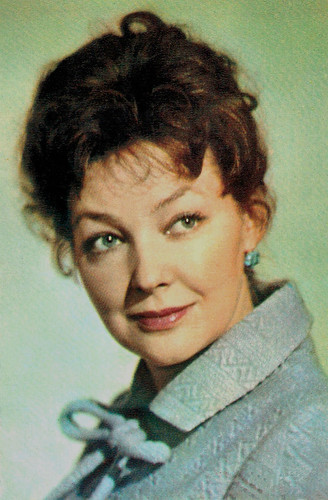
Soviet postcard by Izdanie Bjuro Propagandy Sovetskogo Kinoiskusstva, no. A05978, 1968. The card was issued in 300,000 copies. Retail price: 8 Kop.
Miss Charm of the Cannes Film Festival
Irina Konstantinovna Skobtseva (Russian: Ирина Константиновна Скобцева) was born in 1927 in Tula, USSR (now Russia). Her father, Konstantin Skobtsev, was a meteorology scientist, her mother, Julia Nikolaevna, was an archive researcher.
After graduation, Irina entered the art department of Moscow State University. While studying, she played in the student theatre. After graduating in 1952, she entered the Moscow Art Theatre School, from which she graduated in 1955.
In the same year, Irina Skobtseva made her cinema debut as Desdemona in the Shakespearian drama Otello/Othello (Sergei Yutkevich, 1955) opposite Sergei Bondarchuk . The picture won the Best Director award at the 1956 Cannes Film Festival, and Skobtseva was awarded the title 'Miss Charm of the Cannes Film Festival'.
After Otello, Irina Skobtseva, who remained in the audience's view primarily as a romantic heroine, turned to character acting. She played Cyrus in the film adaptation of Leonid Leonov's play Obyknovennyy chelovek/The Ordinary Man (Aleksandr Stolbov, 1956) and Klavdia Nikolaevna in Nepovtorimaya vesna/Unrepeatable Spring (Aleksandr Stolper, 1957), starring Yevgeniya Kozyreva and Izolda Izvitskaya .
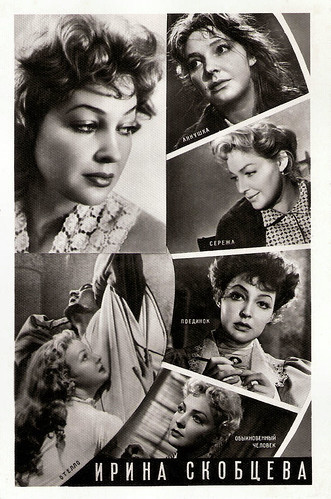
Soviet multiview postcard by Izdanie Bjuro Propagandy Sojuza rabotnikov kinematografii SSSR, Moscow, no. 16380, 1960. Irina Skobtseva in scenes from Otello/Othello (Sergei Yutkevich, 1955), Obyknovennyy chelovek/The Ordinary Man (Aleksandr Stolbov, 1956), Ivan Franko (Timofei Levchuk, 1956), Nepovtorimaya vesna/Unrepeatable Spring (Aleksandr Stolper, 1957), Poyedinok/Duel (Vladimir Petrov, 1957), Annushka (Boris Barnet, 1959), and Seryozha/A Summer to Remember (Georgiy Daneliya, Igor Talankin, 1960).
The most expensive film ever made
In 1959, Irina Skobtseva married actor and director Sergei Bondarchuk who had been her partner in Otello/Othello. This laid the foundations for a series of joint works in the cinema.
Skobtseva shot to fame as Helen Kuragina in Bondarchuk's epic Voyna i mir/War and Peace (Sergey Bondarchuk, 1966). The eight-hour epic became the most expensive film ever made. The film was produced over a period of seven years, from 1961 to 1968, at an estimated cost of $100,000,000 (about one billion dollars adjusted for inflation in 2010).
Voyna i mir set several records, such as involving over three hundred professional actors from several countries. Tens of thousands of extras from the Red Army appeared in the filming of the 3rd two-hour-long episode about the historic Battle of Borodino against Napoleon's invasion. This made it the largest battle scene ever filmed.
Voyna i mir won the 1969 Academy Award for Best Foreign Language Film. Skobtseva played in the films produced by Bondarchuk himself like Oni srazhalis za rodinu/They Fought for Their Country (Sergey Bondarchuk, 1975), Step/Steppe (Sergey Bondarchuk, 1977), and Boris Godunov (Sergey Bondarchuk, 1986).
She also played in films by other directors — Seryozha/Splendid Days (Georgiy Daneliya, Igor Talankin, 1960), Molchaniye doktora Ivensa/Silence of Doctor Evans (Budimir Metalnikov, 1973), Vybor tseli/Take Aim (Igor Talankin, 1975), Otets Sergiy/Father Sergius (Igor Talankin, 1978), and Barkhatnyy sezon/Velvet Season (Vladimir Pavlovich, 1979).
Skobtseva also performed roles in such films of Bondarchuk as Waterloo (Sergey Bondarchuk, 1970) with Rod Steiger and Orson Welles , Krasnye kolokola, film vtoroy - Ya videl rozhdenie novogo mira/Red Bells II (Sergey Bondarchuk, 1982) with Franco Nero , and Quiet Flows the Don (1992) with Rupert Everett - the last work of Sergei Bondarchuk .
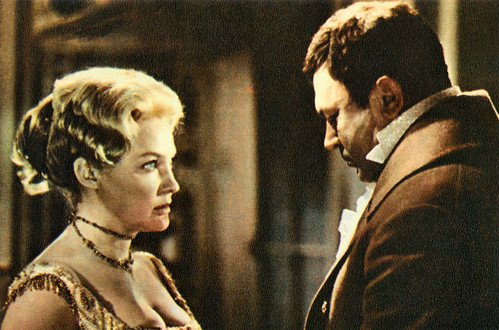
Soviet postcard by Izdanie Bjuro Propagandy Sovetskogo Kinoiskusstva, no. A 08347, 1969. Photo: Irina Skobtseva and Sergey Bondarchuk in Voyna i mir/War and Peace (Sergey Bondarchuk, 1966). This postcard was printed in an edition of 500.000 cards. Retail price: 6 Kop.
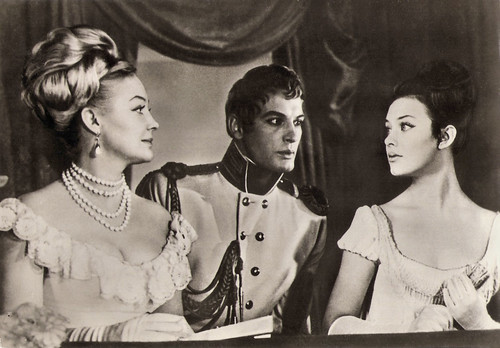
East-German postcard by VEB Progress Filmvertrieb, Berlin no. 2744, 1966. Retail price was 0,20 MDN. Photo: publicity still for Voyna i mir/War and Peace (Sergei Bondarchuk, 1965-1967) with Lyudmila Savelyeva (Natacha Rostova), Irina Skobtseva (Hélène Kuragin), Vasili Lanovoy (Anatol Kuragin).
People's Artist of the RSFSR
Irina Skobtseva appeared as a comedic actress in the films of Georgiy Daneliya, such as Ya shagayu po Moskve/Walking the Streets of Moscow (1963), Tridtsat tri/Thirty-Three (1965), and Sovsem propashchiy/Hopelessly Lost (1973).
One of her best comedy roles is Lidia Sergeevna in the film Eldar Ryazanov's Zigzag udachi/Zigzag of Success (1969).
In the 1980s, Irina Skobtseva semi-retired, but she made some appearances in films and on television since. The actress played major roles in the films Zagadochnyy naslednik/The Mysterious Heir (Tamara Lisitsian, 1987), Besy/The Possessed (Dmitri Talankin, Igor Talankin, 1992), and Zorka venera/Zorka Venus (Margarita Kasymova, 2000).
On TV, Skobtseva starred in the series Zhenskaya logika/The Heirs (Eldor Urazbaev, 2001; Viktor Buturlin, 2005), and Belaya gvardiya/The White Guard (2012).
Later she appeared in the family film Tayna tyomnoy komnaty/The Secret of the Dark Room (Olga Belyaeva, 2014). Her final film role was in the family film Opasnye kanikuly/A dangerous vacation (Olga Belyaeva, 2016).
Since 1957, Skobtseva was an actress of the National Film Actors' Theatre, and since 1971, she taught acting, was an assistant professor of the department of acting at VGIK, and together with Sergei Bondarchuk , she led an acting studio. Irina Skobtseva received the title People's Artist of the RSFSR in 1974. In 1997, she was awarded the Order of Friendship.
Irina Skobtseva passed away in Moscow, Russia. With Sergei Bondarchuk , she had a daughter, actress Yelena Bondarchuk, and a son, Fyodor Bondarchuk, a film director, actor and producer, and chairman of the board of directors of Lenfilm.
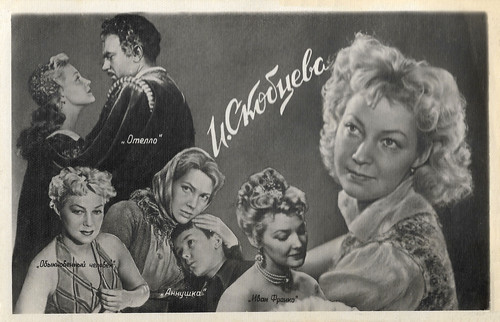
Russian multiview postcard by FK, Rostov on Don, Engels, no. 54. The card was issued in 100,000 copies. Pictures from Otello/Othello (Sergei Yutkevich, 1955), Obyknovennyy chelovek/The Ordinary Man (Aleksandr Stolbov, 1956), Annushka (Boris Barnet, 1959), and Ivan Franko (Timofei Levchuk, 1956).
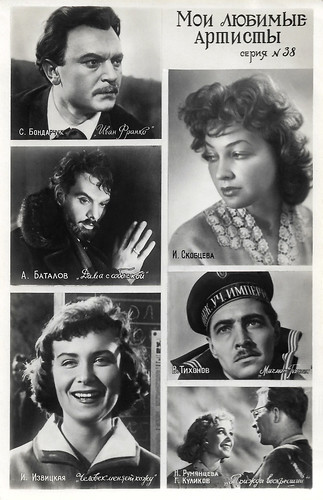
Russian postcard, series no. 38. Caption: My favourite artists. Film stars pictured are amongst others Sergei Bondarchuk, Aleksey Batalov, Izolda Izvitskaya, Irina Skobtseva, and Vyacheslav Tikhonov.
Sources: (IMDb), Wikipedia, and .

Soviet postcard by Izdanie Bjuro Propagandy Sovetskogo Kinoiskusstva, no. A05978, 1968. The card was issued in 300,000 copies. Retail price: 8 Kop.
Miss Charm of the Cannes Film Festival
Irina Konstantinovna Skobtseva (Russian: Ирина Константиновна Скобцева) was born in 1927 in Tula, USSR (now Russia). Her father, Konstantin Skobtsev, was a meteorology scientist, her mother, Julia Nikolaevna, was an archive researcher.
After graduation, Irina entered the art department of Moscow State University. While studying, she played in the student theatre. After graduating in 1952, she entered the Moscow Art Theatre School, from which she graduated in 1955.
In the same year, Irina Skobtseva made her cinema debut as Desdemona in the Shakespearian drama Otello/Othello (Sergei Yutkevich, 1955) opposite Sergei Bondarchuk . The picture won the Best Director award at the 1956 Cannes Film Festival, and Skobtseva was awarded the title 'Miss Charm of the Cannes Film Festival'.
After Otello, Irina Skobtseva, who remained in the audience's view primarily as a romantic heroine, turned to character acting. She played Cyrus in the film adaptation of Leonid Leonov's play Obyknovennyy chelovek/The Ordinary Man (Aleksandr Stolbov, 1956) and Klavdia Nikolaevna in Nepovtorimaya vesna/Unrepeatable Spring (Aleksandr Stolper, 1957), starring Yevgeniya Kozyreva and Izolda Izvitskaya .

Soviet multiview postcard by Izdanie Bjuro Propagandy Sojuza rabotnikov kinematografii SSSR, Moscow, no. 16380, 1960. Irina Skobtseva in scenes from Otello/Othello (Sergei Yutkevich, 1955), Obyknovennyy chelovek/The Ordinary Man (Aleksandr Stolbov, 1956), Ivan Franko (Timofei Levchuk, 1956), Nepovtorimaya vesna/Unrepeatable Spring (Aleksandr Stolper, 1957), Poyedinok/Duel (Vladimir Petrov, 1957), Annushka (Boris Barnet, 1959), and Seryozha/A Summer to Remember (Georgiy Daneliya, Igor Talankin, 1960).
The most expensive film ever made
In 1959, Irina Skobtseva married actor and director Sergei Bondarchuk who had been her partner in Otello/Othello. This laid the foundations for a series of joint works in the cinema.
Skobtseva shot to fame as Helen Kuragina in Bondarchuk's epic Voyna i mir/War and Peace (Sergey Bondarchuk, 1966). The eight-hour epic became the most expensive film ever made. The film was produced over a period of seven years, from 1961 to 1968, at an estimated cost of $100,000,000 (about one billion dollars adjusted for inflation in 2010).
Voyna i mir set several records, such as involving over three hundred professional actors from several countries. Tens of thousands of extras from the Red Army appeared in the filming of the 3rd two-hour-long episode about the historic Battle of Borodino against Napoleon's invasion. This made it the largest battle scene ever filmed.
Voyna i mir won the 1969 Academy Award for Best Foreign Language Film. Skobtseva played in the films produced by Bondarchuk himself like Oni srazhalis za rodinu/They Fought for Their Country (Sergey Bondarchuk, 1975), Step/Steppe (Sergey Bondarchuk, 1977), and Boris Godunov (Sergey Bondarchuk, 1986).
She also played in films by other directors — Seryozha/Splendid Days (Georgiy Daneliya, Igor Talankin, 1960), Molchaniye doktora Ivensa/Silence of Doctor Evans (Budimir Metalnikov, 1973), Vybor tseli/Take Aim (Igor Talankin, 1975), Otets Sergiy/Father Sergius (Igor Talankin, 1978), and Barkhatnyy sezon/Velvet Season (Vladimir Pavlovich, 1979).
Skobtseva also performed roles in such films of Bondarchuk as Waterloo (Sergey Bondarchuk, 1970) with Rod Steiger and Orson Welles , Krasnye kolokola, film vtoroy - Ya videl rozhdenie novogo mira/Red Bells II (Sergey Bondarchuk, 1982) with Franco Nero , and Quiet Flows the Don (1992) with Rupert Everett - the last work of Sergei Bondarchuk .

Soviet postcard by Izdanie Bjuro Propagandy Sovetskogo Kinoiskusstva, no. A 08347, 1969. Photo: Irina Skobtseva and Sergey Bondarchuk in Voyna i mir/War and Peace (Sergey Bondarchuk, 1966). This postcard was printed in an edition of 500.000 cards. Retail price: 6 Kop.

East-German postcard by VEB Progress Filmvertrieb, Berlin no. 2744, 1966. Retail price was 0,20 MDN. Photo: publicity still for Voyna i mir/War and Peace (Sergei Bondarchuk, 1965-1967) with Lyudmila Savelyeva (Natacha Rostova), Irina Skobtseva (Hélène Kuragin), Vasili Lanovoy (Anatol Kuragin).
People's Artist of the RSFSR
Irina Skobtseva appeared as a comedic actress in the films of Georgiy Daneliya, such as Ya shagayu po Moskve/Walking the Streets of Moscow (1963), Tridtsat tri/Thirty-Three (1965), and Sovsem propashchiy/Hopelessly Lost (1973).
One of her best comedy roles is Lidia Sergeevna in the film Eldar Ryazanov's Zigzag udachi/Zigzag of Success (1969).
In the 1980s, Irina Skobtseva semi-retired, but she made some appearances in films and on television since. The actress played major roles in the films Zagadochnyy naslednik/The Mysterious Heir (Tamara Lisitsian, 1987), Besy/The Possessed (Dmitri Talankin, Igor Talankin, 1992), and Zorka venera/Zorka Venus (Margarita Kasymova, 2000).
On TV, Skobtseva starred in the series Zhenskaya logika/The Heirs (Eldor Urazbaev, 2001; Viktor Buturlin, 2005), and Belaya gvardiya/The White Guard (2012).
Later she appeared in the family film Tayna tyomnoy komnaty/The Secret of the Dark Room (Olga Belyaeva, 2014). Her final film role was in the family film Opasnye kanikuly/A dangerous vacation (Olga Belyaeva, 2016).
Since 1957, Skobtseva was an actress of the National Film Actors' Theatre, and since 1971, she taught acting, was an assistant professor of the department of acting at VGIK, and together with Sergei Bondarchuk , she led an acting studio. Irina Skobtseva received the title People's Artist of the RSFSR in 1974. In 1997, she was awarded the Order of Friendship.
Irina Skobtseva passed away in Moscow, Russia. With Sergei Bondarchuk , she had a daughter, actress Yelena Bondarchuk, and a son, Fyodor Bondarchuk, a film director, actor and producer, and chairman of the board of directors of Lenfilm.

Russian multiview postcard by FK, Rostov on Don, Engels, no. 54. The card was issued in 100,000 copies. Pictures from Otello/Othello (Sergei Yutkevich, 1955), Obyknovennyy chelovek/The Ordinary Man (Aleksandr Stolbov, 1956), Annushka (Boris Barnet, 1959), and Ivan Franko (Timofei Levchuk, 1956).

Russian postcard, series no. 38. Caption: My favourite artists. Film stars pictured are amongst others Sergei Bondarchuk, Aleksey Batalov, Izolda Izvitskaya, Irina Skobtseva, and Vyacheslav Tikhonov.
Sources: (IMDb), Wikipedia, and .
Published on October 21, 2020 22:00
October 20, 2020
Elisa Cegani
Elisa Cegani (1911–1996) was one of the most representative actresses of Italian cinema of the 1930s and 1940s. She was the muse of director Alessandro Blasetti and appeared in almost all his films. Cegani appeared in 60 films between 1935 and 1983.
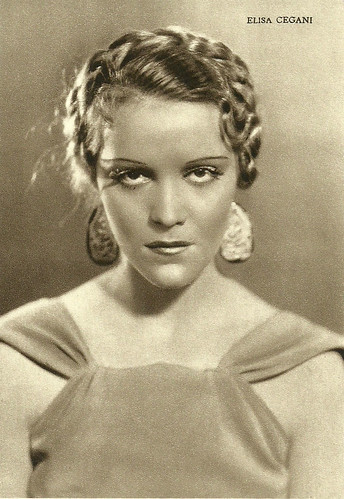
Italian postcard ny Rizzoli & C., Milano, 1936.
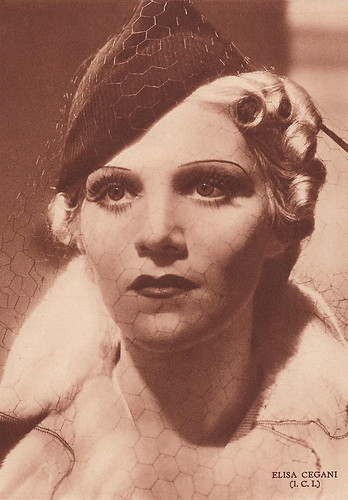
Italian postcard by Rizzoli & C., Milano, 1937. Photo: I.C.I.
Lover or sister?
Elisa Cegani was born in 1911 in Turin. She was accredited at the beginning of her career also with the pseudonym of Elisa Sandri.
She made her debut on the screen in the Italian navy drama Aldebaran (1935), directed by Alessandro Blasetti. Actress and director would remain forever linked, sentimentally, as well as working together on almost all his films and television works, up to the 1979 RAI miniseries Racconti di Fantascienza.
Thus she was e.g. a mannequin pretending to be a countess in the comedy Contessa di Parma/The Countess of Parma (Alessandro Blasetti, 1937), Gino Cervi 's love interest in the historical film Ettore Fieramosca (Alessandro Blasetti, 1938), and Massimo Girotti 's lover (but as later comes out his sister) in the Medieval fantasy La corona di ferro/The Iron Crown (Alessandro Blasetti, 1941), also with Cervi and Luisa Ferida.
In the 1930s Cegani would also work with other directors and played in the romantic comedy Ma non è una cosa seria/But It's Nothing Serious (Mario Camerini, 1936) opposite Vittorio De Sica , and Cavalleria/Cavalry (Goffredo Alessandrini, 1936).
In Cavalleria, she was the delicate aristocratic Speranza who renounces her love for the handsome cavalryman Umberto Solaro (Amedeo Nazzari), marrying an Austrian baron to save her family. After his racehorse has died he becomes a WWI pilot.
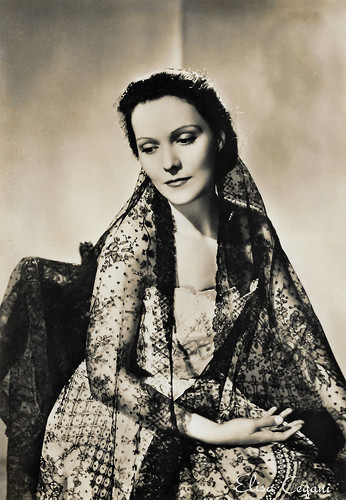
Italian postcard by Rotalfoto, Milano, no. 43.
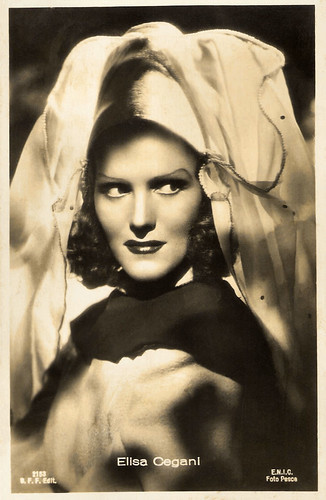
Italian postcard by B.F.F. Edit (Balleri & Fratini, Firenze), no. 2153. Photo: Pesce / E.N.I.C. Elisa Cegani in La corona di ferro/The Iron Crown (Alessandro Blasetti, 1941).
Nietzsche's mother
In the postwar years, Elisa Cegani would continue to act in Alessandro Blasetti's films, e.g. in the war film Un giorno nella vita/A Day in Life (Alessandro Blasetti, 1946), the historical drama Fabiola (Alessandro Blasetti, 1949), starring Michèle Morgan and Henri Vidal , Altri tempi/In Olden Days (Alessandro Blasetti, 1952), and Tempi nostri/A Slice of Life (Alessandro Blasetti, 1954).
Despite some important roles such as the title role in Eleonora Duse (Filippo Walter Ratti, 1947) and Giuseppina Strepponi in Casa Ricordi/House of Ricordi(Carmine Gallone, 1954), her activity became more limited to less important films or secondary parts.
In the late 1960s, she was recalled by great authors. She participated in Le clan des Siciliens/The Sicilian Clan (Henri Verneuil, 1969), while in Liliana Cavani's Al di là del bene e del male/Beyond good and evil (1977), she played Nietzsche's mother.
Cegani was also a theatre and television actress, for which she played e.g. in 1966 the television drama Luisa Sanfelice, directed by Leonardo Cortese . Her last film part Cegani had in Domani si balla!/Tomorrow We Dance (Maurizio Nichetti, 1982), a comedy about aliens sending signals through television.
Elisa Cegani died in Rome in 1996. She was 84.
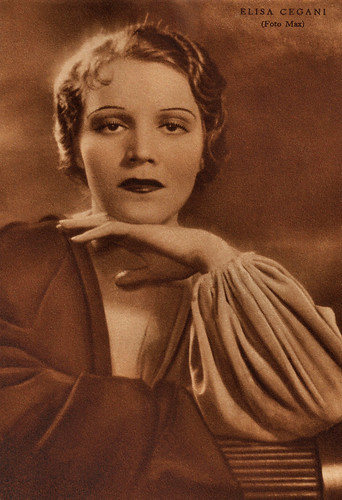
Italian postcard by Rizzoli, Milano, 1938 XVI. Photo: Max.
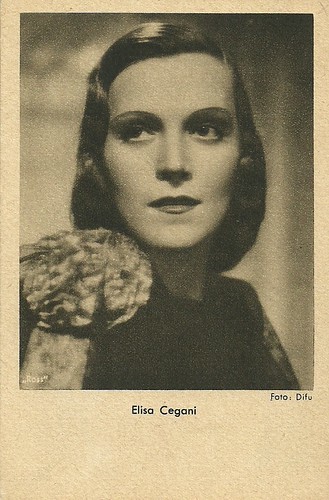
German postcard for Das Programm von Heute, Berlin, by Ross Verlag. Photo: Difu
Sources: Wikipedia (Italian and English) and .

Italian postcard ny Rizzoli & C., Milano, 1936.

Italian postcard by Rizzoli & C., Milano, 1937. Photo: I.C.I.
Lover or sister?
Elisa Cegani was born in 1911 in Turin. She was accredited at the beginning of her career also with the pseudonym of Elisa Sandri.
She made her debut on the screen in the Italian navy drama Aldebaran (1935), directed by Alessandro Blasetti. Actress and director would remain forever linked, sentimentally, as well as working together on almost all his films and television works, up to the 1979 RAI miniseries Racconti di Fantascienza.
Thus she was e.g. a mannequin pretending to be a countess in the comedy Contessa di Parma/The Countess of Parma (Alessandro Blasetti, 1937), Gino Cervi 's love interest in the historical film Ettore Fieramosca (Alessandro Blasetti, 1938), and Massimo Girotti 's lover (but as later comes out his sister) in the Medieval fantasy La corona di ferro/The Iron Crown (Alessandro Blasetti, 1941), also with Cervi and Luisa Ferida.
In the 1930s Cegani would also work with other directors and played in the romantic comedy Ma non è una cosa seria/But It's Nothing Serious (Mario Camerini, 1936) opposite Vittorio De Sica , and Cavalleria/Cavalry (Goffredo Alessandrini, 1936).
In Cavalleria, she was the delicate aristocratic Speranza who renounces her love for the handsome cavalryman Umberto Solaro (Amedeo Nazzari), marrying an Austrian baron to save her family. After his racehorse has died he becomes a WWI pilot.

Italian postcard by Rotalfoto, Milano, no. 43.

Italian postcard by B.F.F. Edit (Balleri & Fratini, Firenze), no. 2153. Photo: Pesce / E.N.I.C. Elisa Cegani in La corona di ferro/The Iron Crown (Alessandro Blasetti, 1941).
Nietzsche's mother
In the postwar years, Elisa Cegani would continue to act in Alessandro Blasetti's films, e.g. in the war film Un giorno nella vita/A Day in Life (Alessandro Blasetti, 1946), the historical drama Fabiola (Alessandro Blasetti, 1949), starring Michèle Morgan and Henri Vidal , Altri tempi/In Olden Days (Alessandro Blasetti, 1952), and Tempi nostri/A Slice of Life (Alessandro Blasetti, 1954).
Despite some important roles such as the title role in Eleonora Duse (Filippo Walter Ratti, 1947) and Giuseppina Strepponi in Casa Ricordi/House of Ricordi(Carmine Gallone, 1954), her activity became more limited to less important films or secondary parts.
In the late 1960s, she was recalled by great authors. She participated in Le clan des Siciliens/The Sicilian Clan (Henri Verneuil, 1969), while in Liliana Cavani's Al di là del bene e del male/Beyond good and evil (1977), she played Nietzsche's mother.
Cegani was also a theatre and television actress, for which she played e.g. in 1966 the television drama Luisa Sanfelice, directed by Leonardo Cortese . Her last film part Cegani had in Domani si balla!/Tomorrow We Dance (Maurizio Nichetti, 1982), a comedy about aliens sending signals through television.
Elisa Cegani died in Rome in 1996. She was 84.

Italian postcard by Rizzoli, Milano, 1938 XVI. Photo: Max.

German postcard for Das Programm von Heute, Berlin, by Ross Verlag. Photo: Difu
Sources: Wikipedia (Italian and English) and .
Published on October 20, 2020 22:00
October 19, 2020
Amore rosso (1921)
Italian diva Maria Jacobini was the star of the Italian silent film Amore rosso/Red love (Gennaro Righelli, 1921), based on the novel 'Milotona' by Théophile Gautier, and produced by Fert Film. The film had an all-star cast including Lido Manetti, Amleto Novelli, Oreste Bilancia, Ida Carloni Talli, Alfonso Cassini and Orietta Claudi. Ballerini & Fratini in Florence and Fotominio in Milan both made a series of postcards for the film.
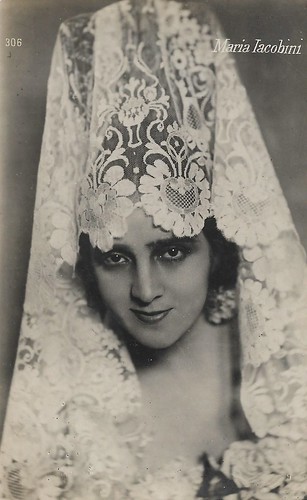
Italian postcard by Ballerini & Fratini, Florence, no. 306. Maria Jacobini in Amore rosso (Gennaro Righelli, 1921).
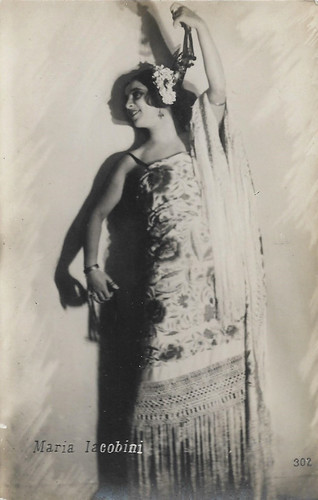
Italian postcard by Ballerini & Fratini, Florence, no. 302. Maria Jacobini in Amore rosso (Gennaro Righelli, 1921).
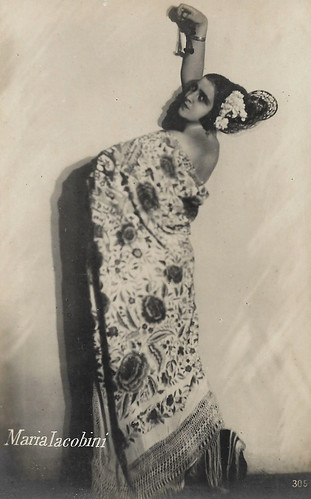
Italian postcard by Ballerini & Fratini, Florence, no. 305. Maria Jacobini in Amore rosso (Gennaro Righelli, 1921).
Love and death around the arena
In Amore rosso/Red love (Gennaro Righelli, 1921), Don Alvaro ( Lido Manetti ) is attracted by the pretty commoner Juanita ( Maria Jacobini ), though he is betrothed to Donna Isabella (Orietta Claudi).
Juanita's friend, the famous torero Barrena ( Amleto Novelli ) is overcome by jealousy when he sees Juanita with another man. He challenges Alvaro to a duel and wounds him.
He is taken to Juanita's house, who lovingly cares for him. Alarmed by Don Alvaro's disappearance, his family searches for him around the city, until they find him in Juanita's humble house and discover that he is taking care of by Juanita
Isabella expresses her disgust for the lower class and pours all her contempt on Alvaro, but Alvaro rejects Isabella and stays with Juanita.
Barrena in the meanwhile accepts his loss. In the arena, he prepares for the last bullfight: incites the bull and commits suicide by letting the bull pierce him.
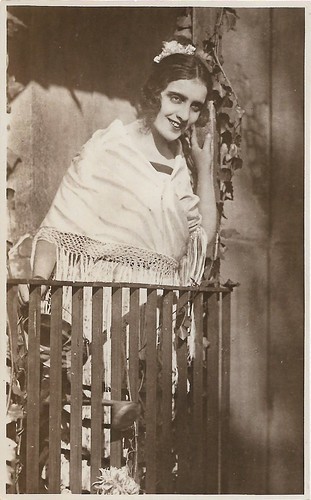
Italian postcard by Fotominio. Photo: G.B. Falci / Fert Film, Milano. Maria Jacobini in Amore rosso (Gennaro Righelli, 1921). Caption: The beautiful Juanita.
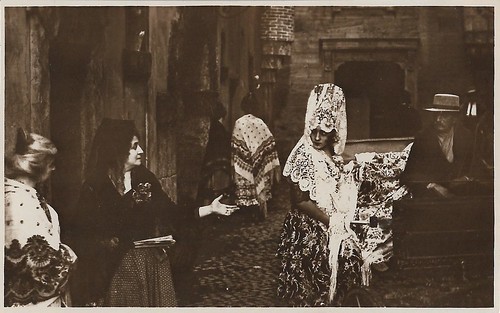
Italian postcard by Fotominio. Photo: G.B. Falci, Milano / Fert. Ida Carloni Talli and Maria Jacobini in Amore rosso (Gennaro Righelli, 1921). Caption: Juanita goes to the corrida with her aunt Curra.
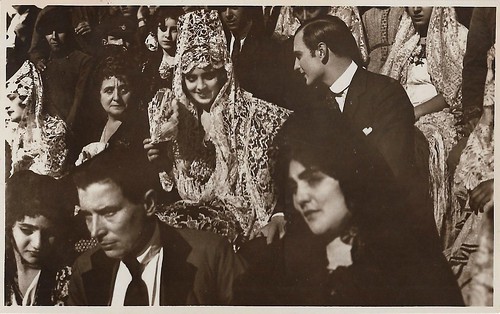
Italian postcard by Fotominio. Photo: G.B. Falci, Milano / Fert. Ida Carloni Talli , Maria Jacobini and Lido Manetti in Amore rosso (Gennaro Righelli, 1921). Caption: During the corrida. Don Alvaro gets to know Juanita.
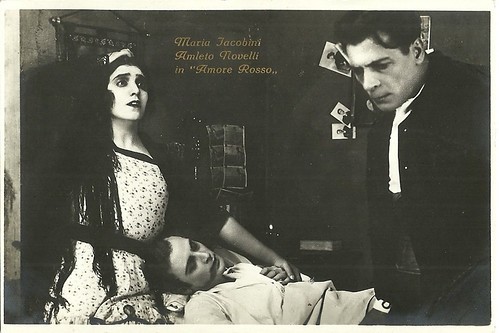
Italian postcard by Fotominio. Photo: G.B. Falci, Milano / Fert. Maria Jacobini , Lido Manetti and Amleto Novelli in Amore rosso (Gennaro Righelli, 1921).
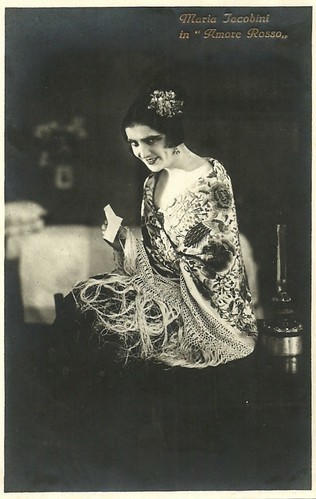
Italian postcard. Photo: G.B. Falci, Milano / Fert. Maria Jacobini in Amore rosso (Gennaro Righelli, 1921).
Sources: Vittorio Martinelli (The Italian silent cinema 1921-22), Wikipedia (Italian) and IMDb.

Italian postcard by Ballerini & Fratini, Florence, no. 306. Maria Jacobini in Amore rosso (Gennaro Righelli, 1921).

Italian postcard by Ballerini & Fratini, Florence, no. 302. Maria Jacobini in Amore rosso (Gennaro Righelli, 1921).

Italian postcard by Ballerini & Fratini, Florence, no. 305. Maria Jacobini in Amore rosso (Gennaro Righelli, 1921).
Love and death around the arena
In Amore rosso/Red love (Gennaro Righelli, 1921), Don Alvaro ( Lido Manetti ) is attracted by the pretty commoner Juanita ( Maria Jacobini ), though he is betrothed to Donna Isabella (Orietta Claudi).
Juanita's friend, the famous torero Barrena ( Amleto Novelli ) is overcome by jealousy when he sees Juanita with another man. He challenges Alvaro to a duel and wounds him.
He is taken to Juanita's house, who lovingly cares for him. Alarmed by Don Alvaro's disappearance, his family searches for him around the city, until they find him in Juanita's humble house and discover that he is taking care of by Juanita
Isabella expresses her disgust for the lower class and pours all her contempt on Alvaro, but Alvaro rejects Isabella and stays with Juanita.
Barrena in the meanwhile accepts his loss. In the arena, he prepares for the last bullfight: incites the bull and commits suicide by letting the bull pierce him.

Italian postcard by Fotominio. Photo: G.B. Falci / Fert Film, Milano. Maria Jacobini in Amore rosso (Gennaro Righelli, 1921). Caption: The beautiful Juanita.

Italian postcard by Fotominio. Photo: G.B. Falci, Milano / Fert. Ida Carloni Talli and Maria Jacobini in Amore rosso (Gennaro Righelli, 1921). Caption: Juanita goes to the corrida with her aunt Curra.

Italian postcard by Fotominio. Photo: G.B. Falci, Milano / Fert. Ida Carloni Talli , Maria Jacobini and Lido Manetti in Amore rosso (Gennaro Righelli, 1921). Caption: During the corrida. Don Alvaro gets to know Juanita.

Italian postcard by Fotominio. Photo: G.B. Falci, Milano / Fert. Maria Jacobini , Lido Manetti and Amleto Novelli in Amore rosso (Gennaro Righelli, 1921).

Italian postcard. Photo: G.B. Falci, Milano / Fert. Maria Jacobini in Amore rosso (Gennaro Righelli, 1921).
Sources: Vittorio Martinelli (The Italian silent cinema 1921-22), Wikipedia (Italian) and IMDb.
Published on October 19, 2020 22:00
October 18, 2020
Aline Carola
Beautiful Aline Carola (1921-1944) was a talented French actress who died at the age of only 23. She played in three films in 1942.
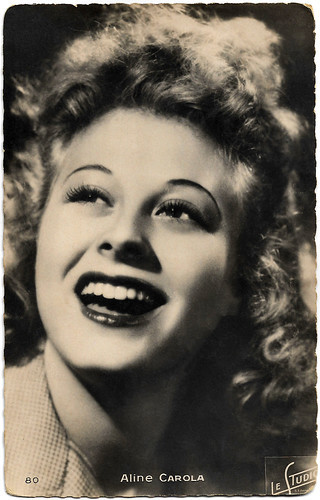
French postcard by Editions E.C., Paris, no. 80. Photo: Le Studio.
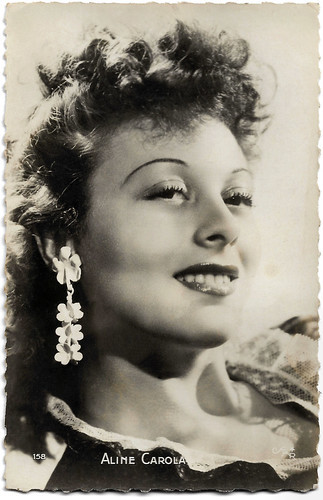
French postcard by Editions P.I., Paris, no. 158. Photo: Star.
The cinema winked
Aline Carola was born Denise Emilienne Haezebaert ( IMDb writes mistakenly Halzebartz) in Coudekerque-Branche (Dunkerque) in 1921.
She was born into a family of craftsmen and small traders. Her father, Desiré Haezebaert, was a hero of the First World War, decorated with the Legion of Honor, the Military Medal, and the Cross of Wars with palms and several stars, was a carpenter and cabinetmaker, and later a hosier. Her mother was Albertine Haezebaert-Deman.
Aline left the family home very young and moved to Paris to become an actress. There she took lessons in diction, singing and posing. At 16, she started her acting career in small roles on stage.
At the start of the Second World War, she went to live together with Fernand Vitus, manufacturer of radio sets and founder of Radio-Vitus.
At 19, she was celebrated at the Daunou theatre for her interpretation in 'Mon gosse de père' (My father, the kid), a comedy by Léopold Marchand. It led to a role opposite Fernandel in the comedy 'Papa' by Robert de Flers in 1940.
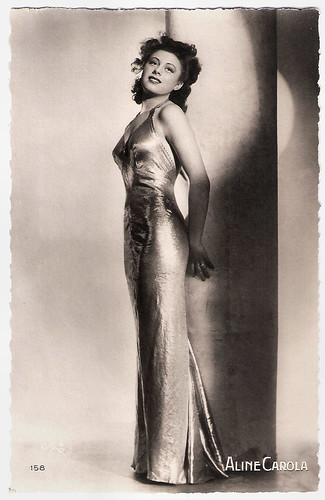
French postcard, no. 158.
A budding career suddenly interrupted
Then the cinema winked to the young actress. La Société Sirus offered her a contract for 5 major film roles. In 1942, Aline Carola played in three films.
First, she had a small part in Dernière Aventure/Last adventure (Robert Péguy, 1942) with André Alerme.
A bigger role followed in Huit hommes dans un château/Eight men in a castle (Richard Pottier, 1942), starring René Dary and Jacqueline Gauthier.
She finally had the main female role opposite René Dary and Paul Azais in the comedy Forte tête/Strong head (Léon Mathot, 1942).
Then her budding career was suddenly interrupted by an illness, pneumonia. It was poorly treated during wartime and she died in 1944. Aline Carola was only 23. She was buried in the Père-Lachaise cemetery. A street in her hometown now bears her name.
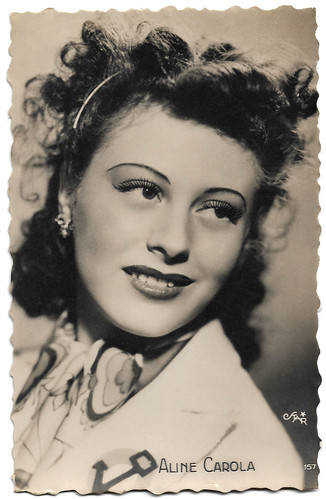
French postcard by Editions P.I., Paris, no. 157. Photo: Star.
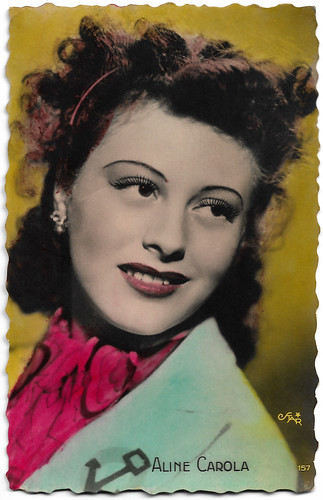
French postcard by Editions P.I., Paris, no. 157. Photo: Star.
Source: Wikipedia (French), Facebook, and .

French postcard by Editions E.C., Paris, no. 80. Photo: Le Studio.

French postcard by Editions P.I., Paris, no. 158. Photo: Star.
The cinema winked
Aline Carola was born Denise Emilienne Haezebaert ( IMDb writes mistakenly Halzebartz) in Coudekerque-Branche (Dunkerque) in 1921.
She was born into a family of craftsmen and small traders. Her father, Desiré Haezebaert, was a hero of the First World War, decorated with the Legion of Honor, the Military Medal, and the Cross of Wars with palms and several stars, was a carpenter and cabinetmaker, and later a hosier. Her mother was Albertine Haezebaert-Deman.
Aline left the family home very young and moved to Paris to become an actress. There she took lessons in diction, singing and posing. At 16, she started her acting career in small roles on stage.
At the start of the Second World War, she went to live together with Fernand Vitus, manufacturer of radio sets and founder of Radio-Vitus.
At 19, she was celebrated at the Daunou theatre for her interpretation in 'Mon gosse de père' (My father, the kid), a comedy by Léopold Marchand. It led to a role opposite Fernandel in the comedy 'Papa' by Robert de Flers in 1940.

French postcard, no. 158.
A budding career suddenly interrupted
Then the cinema winked to the young actress. La Société Sirus offered her a contract for 5 major film roles. In 1942, Aline Carola played in three films.
First, she had a small part in Dernière Aventure/Last adventure (Robert Péguy, 1942) with André Alerme.
A bigger role followed in Huit hommes dans un château/Eight men in a castle (Richard Pottier, 1942), starring René Dary and Jacqueline Gauthier.
She finally had the main female role opposite René Dary and Paul Azais in the comedy Forte tête/Strong head (Léon Mathot, 1942).
Then her budding career was suddenly interrupted by an illness, pneumonia. It was poorly treated during wartime and she died in 1944. Aline Carola was only 23. She was buried in the Père-Lachaise cemetery. A street in her hometown now bears her name.

French postcard by Editions P.I., Paris, no. 157. Photo: Star.

French postcard by Editions P.I., Paris, no. 157. Photo: Star.
Source: Wikipedia (French), Facebook, and .
Published on October 18, 2020 22:00
October 17, 2020
Rhonda Fleming (1923-2020)
American film and television actress Rhonda Fleming (1923-2020) passed away, last Wednesday. 14 October. The 'Queen of Technicolor' acted in more than forty films, mostly in the 1940s and 1950s, and worked with directors such as Alfred Hitchcock on Spellbound (1945), Robert Siodmak on The Spiral Staircase (1946), Jacques Tourneur on Out of the Past (1947), and Fritz Lang on While the City Sleeps (1956). She became renowned as one of the most beautiful and glamorous actresses of her day. Rhonda Fleming was 97.
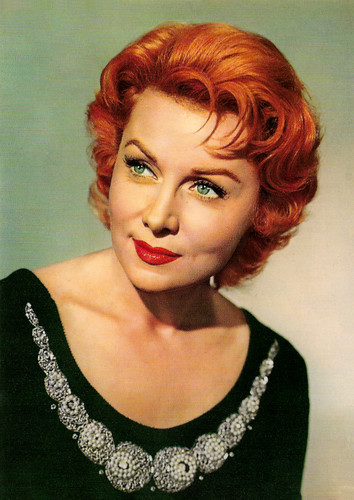
Italian postcard by Rotalcolor / Rotalfoto, Milano, no. N. 58.
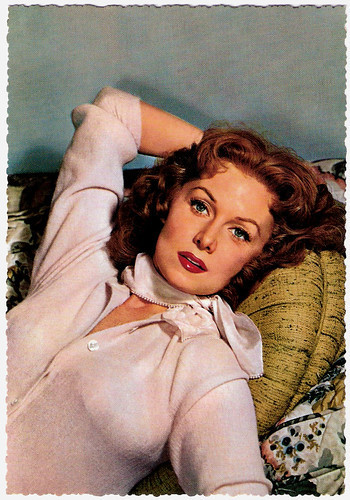
German postcard by Krüger, no. 902/23.
A nymphomaniac being treated by Ingrid Bergman
Rhonda Fleming was born Marilyn Cheverton Louis in Hollywood, in 1923. She was the younger of two daughters of Effie Graham, a model and actress, and Harold Cheverton Louis, who worked in the insurance industry.
Marilyn attended Beverly Hills High and was discovered by the famous agent Henry Willson while on the way to school. She was then signed to a contract with David O. Selznick, and he (or Willson - the sources differ) changed her name to Rhonda Fleming.
Her first major part was as a nymphomaniac being treated by Ingrid Bergman ’s character in the psychological thriller Spellbound (Alfred Hitchcock, 1945). In interviews, she said she was so naive she had to look up the word in the dictionary when she was cast.
She was a turn-of-the-century New England secretary who is murdered by a serial killer (George Brent) in the thriller The Spiral Staircase (Robert Siodmak, 1946). In Jacques Tourneur’s Film Noir Out of the Past (1947), she played a supporting role as a nervous secretary, alongside Robert Mitchum and Kirk Douglas .
Fleming's first leading role came in the South Seas adventure film Adventure Island (Sam Newfield, 1947), a low-budget film made for Pine-Thomas Productions at Paramount Pictures in the two-color Cinecolor process and co-starring fellow Selznick contractee Rory Calhoun.
In the musical fantasy A Connecticut Yankee in King Arthur’s Court (Tay Garnett, 1948) she played a beautiful Arthurian princess opposite Bing Crosby. She then played another leading role opposite a comedian, in this case, Bob Hope, in The Great Lover (Alexander Hall, 1949). It was a big hit and Fleming was established. In 1950, she ended her association with Selznick after eight years, though her contract with him had another five years to run.
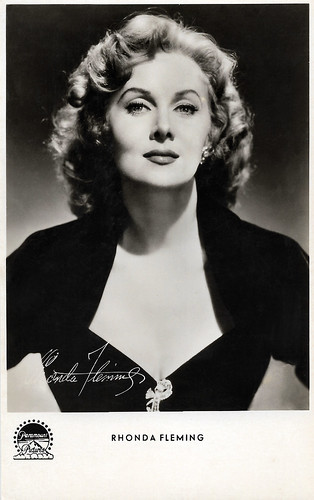
German postcard by Kunst und Bild, Berlin, no. A 1298. Photo: Paramount. Rhonda Fleming in Jivaro (Edward Ludwig, 1954).
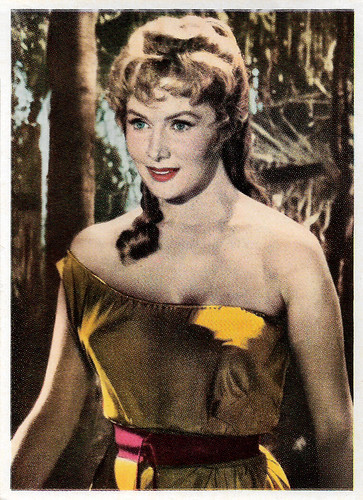
German collectors card in the "Filmstars von Hollywood bis Tokio" series III. Rhonda Fleming in La cortigiana di Babilonia/The Queen of Babylon (Carlo Ludovico Bragaglia, 1954).
Flaming red hair, fair skin, and green eyes
During the 1950s, Rhonda Fleming starred in four films with Ronald Reagan, including Tropic Zone (Lewis R. Foster, 1953), in which his character saved her character’s banana plantation.
Although she tended to be cast as a fresh-faced but sexy American girl, she did play the occasional foreign type. In Little Egypt (Frederick De Cordova, 1951), she portrayed an exotic belly dancer at a world’s fair — although her character turned out to be just a New Jersey girl with a fake accent.
She was Cleopatra in Serpent of the Nile (William Castle, 1953), opposite Raymond Burr as Mark Antony. Along with Maria Montez , Maureen O'Hara , and Yvonne De Carlo , she was bestowed with the nickname of 'Queen of Technicolor' for how well her flaming red hair, fair skin, and green eyes photographed in vivid colour.
In the Film Noir Slightly Scarlet (Allan Dwan, 1956) she was the somewhat less bad sister of Arlene Dahl’s bad-girl character, and in the Western Gunfight at the O.K. Corral (John Sturges, 1957) she played a gambler and the love interest of Wyatt Earp ( Burt Lancaster ).
Her favourite role was the overdressed, over-coiffed stepsister to Jean Simmons ’s character in the thriller Home Before Dark (Mervyn LeRoy, 1958). Other notable roles included the Western Pony Express (Jerry Hopper, 1953), Fritz Lang’s While the City Sleeps (1956) with Dana Andrews , and The Big Circus (Joseph M. Newman, 1959).
She sang in several of her films and was part of a gospel quartet, the Four Girls, with Jane Russell , Connie Haines and Beryl Davis in the 1950s. In 1957 she embarked on a Las Vegas career, performing at the brand-new Tropicana hotel. In 1960, she was awarded a star on the Hollywood Walk of Fame.
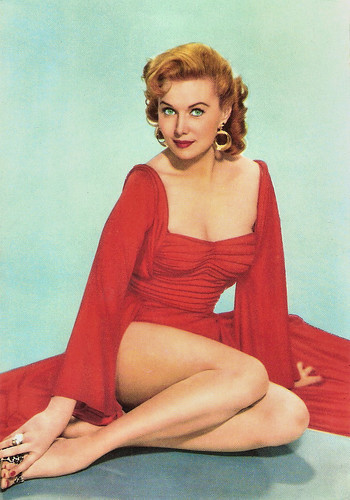
Italian postcard by Rotalcolor.
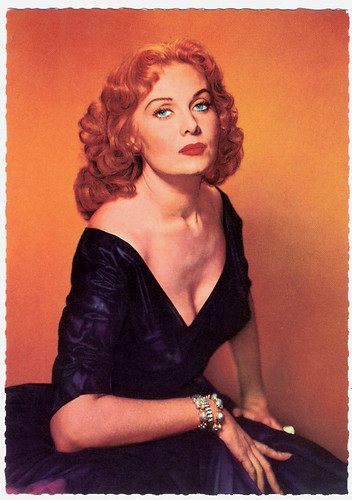
German postcard by ISV, no. A 38. Photo: 20th Century Fox. Rhonda Fleming in Inferno (Roy Ward Baker, 1953).
The dinosaur in Jurassic Park
In the early 1960s, Rhonda Fleming turned almost exclusively to acting on television, where she was active until the late 1970s. She routinely guest-starred on television in series including Wagon Train (1958-1963), The Virginian (1965), Police Woman (1974), Ellery Queen (1975), The Love Boat (1978), and a two-hour special of McMillan & Wife (1975).
She made her Broadway debut in Clare Boothe Luce’s 'The Women' (1973). She was part of an ensemble cast that included Myrna Loy , Alexis Smith, and Kim Hunter . Fleming also toured as Madame Dubonnet in 'The Boyfriend'. Later she appeared at the Hollywood Bowl in a one-woman concert with compositions from Cole Porter and Irving Berlin.
In the cinema, she spoofed herself as 'Rhoda Flaming' in the comedy Won Ton Ton, The Dog Who Saved Hollywood (Michael Winner, 1976) along with a bevy of other vintage performers from Dorothy Lamour to Rudy Vallee.
One of her last film roles was in the Don Adams spy farce The Nude Bomb (Clive Donner, 1980), as Edith Von Secondberg, an international fashion designer.
She became a philanthropist and supporter of numerous organisations fighting cancer, homelessness, and child abuse. In 1991, Fleming and her late husband Ted Mann established Rhonda Fleming Mann Clinic for Comprehensive Care for Women with Cancer at UCLA in memory of her sister Beverly, and in 1992, she founded the Rhonda Fleming Mann Resource Center at UCLA. She opened the Reflections boutique to help cancer patients with items including wigs and prostheses. She also supported Providence Saint John’s Health Center in Santa Monica, Calif., where she established the Rhonda Fleming Carlson Inspiration Garden in 2014.
Rhonda Fleming died Wednesday 14 October 2020 in a hospital in Santa Monica, Calif., at the age of 97. Fleming had six husbands. In 1940 she married Thomas Lane, with whom she had a son. They divorced in 1948. Her second husband was Lew Morrill (1952-1958), a physician, followed by actor Lang Jeffries (1960-1962), and filmmaker Hall Bartlett (1966-1972). All of those marriages ended in divorce. In 1978 she married Ted Mann, owner of the Mann Theaters chain. They were together until his death in 2001. Two years later she married Darol Carlson, who died in 2017.
Fleming is survived by her son, Kent Lane, as well as two granddaughters, five great-grandchildren, and two great-great-grandchildren. In a 1993 interview with The Toronto Star, she said, “My husband recently asked me if I’d seen any movie I wanted to appear in. I said yes, the dinosaur in Jurassic Park.”
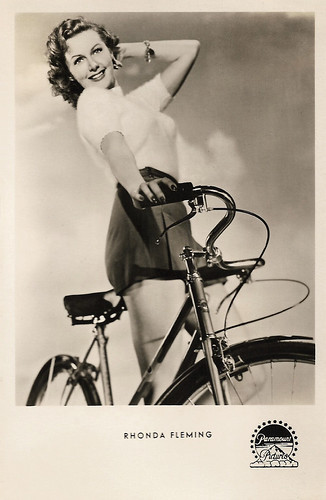
German postcard by Kunst und Bild, Berlin, no. A 357. Photo: Paramount Pictures.
Trailer Pony Express (1953). Source: Trailer Chan (YouTube).
Sources: Natalie Oganesyan (Variety), Anita Gates (New York Times), Wikipedia, and .

Italian postcard by Rotalcolor / Rotalfoto, Milano, no. N. 58.

German postcard by Krüger, no. 902/23.
A nymphomaniac being treated by Ingrid Bergman
Rhonda Fleming was born Marilyn Cheverton Louis in Hollywood, in 1923. She was the younger of two daughters of Effie Graham, a model and actress, and Harold Cheverton Louis, who worked in the insurance industry.
Marilyn attended Beverly Hills High and was discovered by the famous agent Henry Willson while on the way to school. She was then signed to a contract with David O. Selznick, and he (or Willson - the sources differ) changed her name to Rhonda Fleming.
Her first major part was as a nymphomaniac being treated by Ingrid Bergman ’s character in the psychological thriller Spellbound (Alfred Hitchcock, 1945). In interviews, she said she was so naive she had to look up the word in the dictionary when she was cast.
She was a turn-of-the-century New England secretary who is murdered by a serial killer (George Brent) in the thriller The Spiral Staircase (Robert Siodmak, 1946). In Jacques Tourneur’s Film Noir Out of the Past (1947), she played a supporting role as a nervous secretary, alongside Robert Mitchum and Kirk Douglas .
Fleming's first leading role came in the South Seas adventure film Adventure Island (Sam Newfield, 1947), a low-budget film made for Pine-Thomas Productions at Paramount Pictures in the two-color Cinecolor process and co-starring fellow Selznick contractee Rory Calhoun.
In the musical fantasy A Connecticut Yankee in King Arthur’s Court (Tay Garnett, 1948) she played a beautiful Arthurian princess opposite Bing Crosby. She then played another leading role opposite a comedian, in this case, Bob Hope, in The Great Lover (Alexander Hall, 1949). It was a big hit and Fleming was established. In 1950, she ended her association with Selznick after eight years, though her contract with him had another five years to run.

German postcard by Kunst und Bild, Berlin, no. A 1298. Photo: Paramount. Rhonda Fleming in Jivaro (Edward Ludwig, 1954).

German collectors card in the "Filmstars von Hollywood bis Tokio" series III. Rhonda Fleming in La cortigiana di Babilonia/The Queen of Babylon (Carlo Ludovico Bragaglia, 1954).
Flaming red hair, fair skin, and green eyes
During the 1950s, Rhonda Fleming starred in four films with Ronald Reagan, including Tropic Zone (Lewis R. Foster, 1953), in which his character saved her character’s banana plantation.
Although she tended to be cast as a fresh-faced but sexy American girl, she did play the occasional foreign type. In Little Egypt (Frederick De Cordova, 1951), she portrayed an exotic belly dancer at a world’s fair — although her character turned out to be just a New Jersey girl with a fake accent.
She was Cleopatra in Serpent of the Nile (William Castle, 1953), opposite Raymond Burr as Mark Antony. Along with Maria Montez , Maureen O'Hara , and Yvonne De Carlo , she was bestowed with the nickname of 'Queen of Technicolor' for how well her flaming red hair, fair skin, and green eyes photographed in vivid colour.
In the Film Noir Slightly Scarlet (Allan Dwan, 1956) she was the somewhat less bad sister of Arlene Dahl’s bad-girl character, and in the Western Gunfight at the O.K. Corral (John Sturges, 1957) she played a gambler and the love interest of Wyatt Earp ( Burt Lancaster ).
Her favourite role was the overdressed, over-coiffed stepsister to Jean Simmons ’s character in the thriller Home Before Dark (Mervyn LeRoy, 1958). Other notable roles included the Western Pony Express (Jerry Hopper, 1953), Fritz Lang’s While the City Sleeps (1956) with Dana Andrews , and The Big Circus (Joseph M. Newman, 1959).
She sang in several of her films and was part of a gospel quartet, the Four Girls, with Jane Russell , Connie Haines and Beryl Davis in the 1950s. In 1957 she embarked on a Las Vegas career, performing at the brand-new Tropicana hotel. In 1960, she was awarded a star on the Hollywood Walk of Fame.

Italian postcard by Rotalcolor.

German postcard by ISV, no. A 38. Photo: 20th Century Fox. Rhonda Fleming in Inferno (Roy Ward Baker, 1953).
The dinosaur in Jurassic Park
In the early 1960s, Rhonda Fleming turned almost exclusively to acting on television, where she was active until the late 1970s. She routinely guest-starred on television in series including Wagon Train (1958-1963), The Virginian (1965), Police Woman (1974), Ellery Queen (1975), The Love Boat (1978), and a two-hour special of McMillan & Wife (1975).
She made her Broadway debut in Clare Boothe Luce’s 'The Women' (1973). She was part of an ensemble cast that included Myrna Loy , Alexis Smith, and Kim Hunter . Fleming also toured as Madame Dubonnet in 'The Boyfriend'. Later she appeared at the Hollywood Bowl in a one-woman concert with compositions from Cole Porter and Irving Berlin.
In the cinema, she spoofed herself as 'Rhoda Flaming' in the comedy Won Ton Ton, The Dog Who Saved Hollywood (Michael Winner, 1976) along with a bevy of other vintage performers from Dorothy Lamour to Rudy Vallee.
One of her last film roles was in the Don Adams spy farce The Nude Bomb (Clive Donner, 1980), as Edith Von Secondberg, an international fashion designer.
She became a philanthropist and supporter of numerous organisations fighting cancer, homelessness, and child abuse. In 1991, Fleming and her late husband Ted Mann established Rhonda Fleming Mann Clinic for Comprehensive Care for Women with Cancer at UCLA in memory of her sister Beverly, and in 1992, she founded the Rhonda Fleming Mann Resource Center at UCLA. She opened the Reflections boutique to help cancer patients with items including wigs and prostheses. She also supported Providence Saint John’s Health Center in Santa Monica, Calif., where she established the Rhonda Fleming Carlson Inspiration Garden in 2014.
Rhonda Fleming died Wednesday 14 October 2020 in a hospital in Santa Monica, Calif., at the age of 97. Fleming had six husbands. In 1940 she married Thomas Lane, with whom she had a son. They divorced in 1948. Her second husband was Lew Morrill (1952-1958), a physician, followed by actor Lang Jeffries (1960-1962), and filmmaker Hall Bartlett (1966-1972). All of those marriages ended in divorce. In 1978 she married Ted Mann, owner of the Mann Theaters chain. They were together until his death in 2001. Two years later she married Darol Carlson, who died in 2017.
Fleming is survived by her son, Kent Lane, as well as two granddaughters, five great-grandchildren, and two great-great-grandchildren. In a 1993 interview with The Toronto Star, she said, “My husband recently asked me if I’d seen any movie I wanted to appear in. I said yes, the dinosaur in Jurassic Park.”

German postcard by Kunst und Bild, Berlin, no. A 357. Photo: Paramount Pictures.
Trailer Pony Express (1953). Source: Trailer Chan (YouTube).
Sources: Natalie Oganesyan (Variety), Anita Gates (New York Times), Wikipedia, and .
Published on October 17, 2020 22:00
October 16, 2020
Oliver-Film
Today, we have postcards of silent films of the little-known German company Oliver-Film. It was the company of Austrian-born film pioneer David Oliver (1880-1947), who produced over 200 silent films in the 1910s and early 1920s. His grandson, Canadian actor and film producer Mark Oliver, made for HBO the interesting documentary UFA MAN... The Story of Movie Pioneer David Oliver about the life and work of his grandfather. So, who was David Oliver?
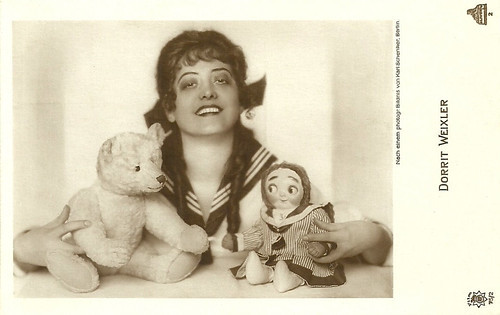
German postcard in the Film-Sterne series by Rotophot, no. 75/2. Photo: Karl Schenker, Berlin / Oliver-Film, no. 2. Dorrit Weixler .
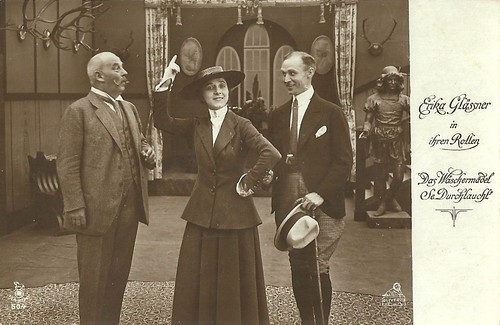
German postcard in the Film-Sterne series by Rotophot, no. 504. Photo: Oliver-Film. Erika Glässner in the silent comedy Das Wäschermädel Seiner Durchlaucht/His Highness's Washing Lady (Danny Kaden, 1917), co-starring Gustav Botz and Karl Beckersachs .
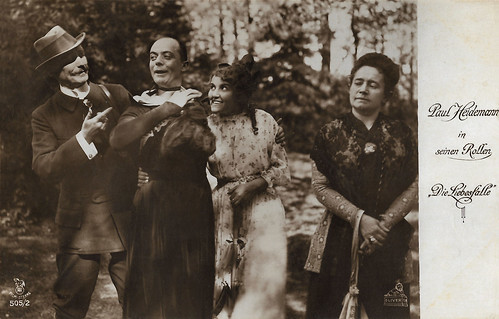
German postcard by Rotophot in the Film Sterne series, no. 505/2. Photo: Oliver-Film. Paul Heidemann in Die Liebesfalle (N.N., 1917).
The business opportunities for a new form of entertainment
David Oliver was born David Olivenbaum, in 1880, in Unizh, Western Galicia (then Austria-Hungary, now Ukraine). He was of the Jewish faith.
To avoid the pogroms that flared up again and again in his homeland, he turned west and opened a cinema in Bremen in 1905, after he had recognised the business opportunities that this new form of entertainment offered him.
Successful as a film salesman, he then built large cinema palaces in Hanover, Dresden, Halle, and above all in Leipzig. Ten years later, he owned his own film company.
When the First World War broke out in 1914, his company, the Berlin Oliver-Film GmbH, controlled around 25 percent of the German film market.
Oliver also headed the Nordische Films Co., so he was head of the German distribution organisation of Nordisk Film, which had been operating in Copenhagen since 1906, and for which top film workers such as Urban Gad, Valdemar Psilander and Asta Nielsen worked or had worked.
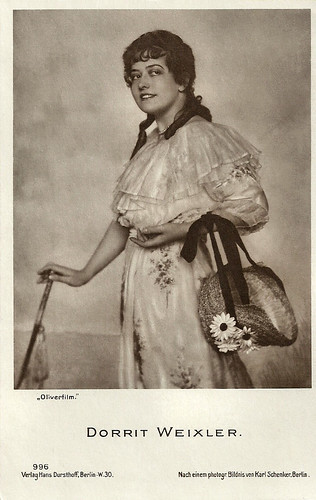
German postcard by Verlag Hans Dursthoff, Berlin, no. 996. Photo: Karl Schenker, Berlin / Oliver-Film. Dorrit Weixler .
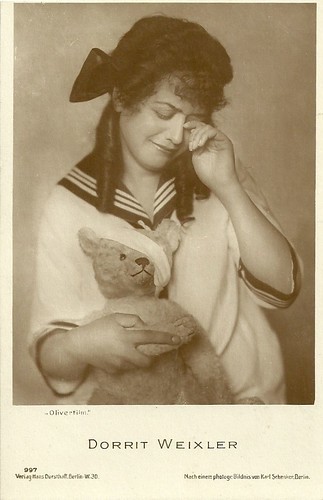
German postcard by Verlag Hans Dursthoff, Berlin, no. 997. Photo: Karl Schenker, Berlin / Oliver Film. Dorrit Weixler .
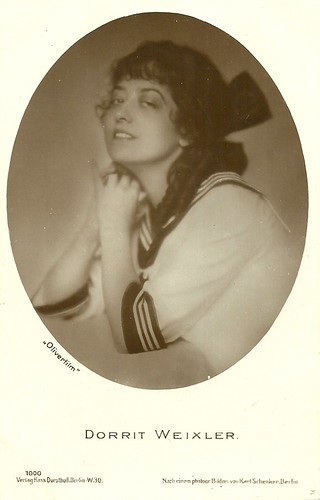
German postcard by Verlag Hans Dursthoff, Berlin, no. 1000. Photo: Karl Schenker, Berlin / Oliver Film. Dorrit Weixler .
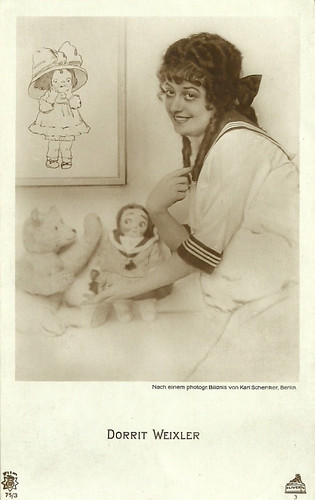
German postcard in the Film-Sterne series by Rotophot, no. 75/3. Photo: Karl Schenker, Berlin / Oliver-Film, 3. Dorrit Weixler .
One of the founding fathers of Ufa
The Berlin Oliver-Film GmbH produced feature films and documentaries. One of the stars was the Berlin actress Dorrit Weixler , with whom several films were made from 1915 onward, often comedies with her first name in the title.
Another prominent star of Oliver-Film was Hilde Wörner , while the comedians Paul Heidemann (known as Paulchen and Teddy), Erika Glässner , Herbert Paulmüller, Melitta Petri, and Leo Peukert were less frequent stars.
Oliver also produced some detective films with Max Landa , such as Der Mann ohne Kopf/The man without a head (Louis Neher, 1916) and Der Hund mit dem Monokel/The dog with the monocle (Felix Basch, 1916).
The documentaries of Oliver-Film included images of nature and landscapes from the near as well as the more distant surroundings, city portraits as well as general or popular educational character and war reports.
In the Spring of 1915, Oliver acquired Paul Davidson's entire chain of Union theaters. Together with Emil Georg von Stauß and Alexander Grau, he was one of the founding fathers of Ufa in November 1917, after Nordisk had teamed up with other German film companies and the Supreme Army Command under General Erich Ludendorff had given their blessing.
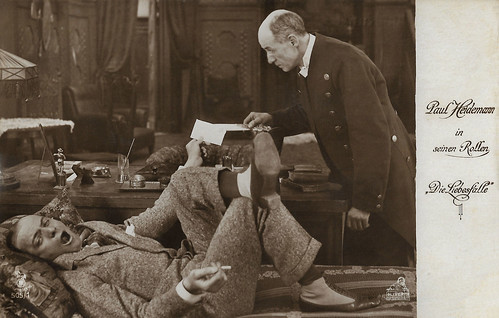
German postcard by Rotophot in the Film Sterne series, no. 505/1. Photo: Oliver-Film. Paul Heidemann in Die Liebesfalle (N.N., 1917).
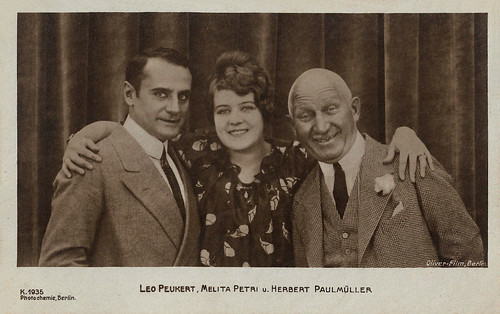
German postcard by Photochemie, Berlin, no. K. 1935. Photo: Oliver-Film, Berlin. Leo Peukert , Melitta Petri and Herbert Paulmüller
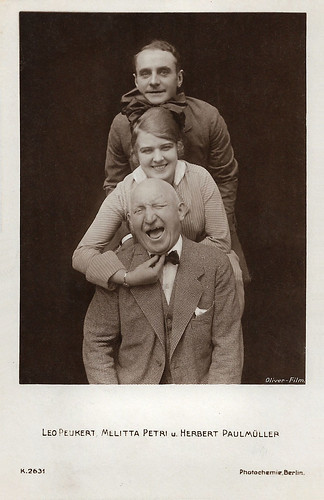
German postcard by Photochemie, Berlin, no. K. 2631. Photo: Oliver-Film, Berlin. Leo Peukert , Melitta Petri and Herbert Paulmüller in Wer niemals einen Rausch gehabt/Who never had an intoxication (Heinrich Bolten-Baeckers, 1918).
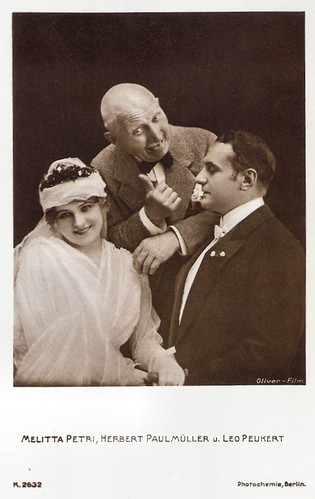
German postcard by Photochemie, Berlin, no. K. 2632. Photo: Oliver-Film, Berlin. Leo Peukert , Melitta Petri and Herbert Paulmüller in Wer niemals einen Rausch gehabt/Who never had an intoxication (Heinrich Bolten-Baeckers, 1918).
The largest movie palace in Europe
In the 1920s, David Oliver shifted the focus of his ventures from film production to the rental and theatre business. In Berlin-Charlottenburg he had Hans Poelzig build the Capitol Theater with over 1,300 seats. It opened on 20 December 1925 with the film The Thief of Bagdad (Raoul Walsh, 1924) starring Douglas Fairbanks .
In 1929 Oliver was involved in the construction of what was then the largest movie palace in Europe with 2,667 seats, the magnificent Ufa-Palast in Hamburg.
On 1 April 1933, UFA dismissed all employees of Jewish descent, including Oliver. On 21 March 1934, somebody threw a hand grenade to a taxi in which Oliver was sitting. Oliver remained unharmed but decided to emigrate to Spain.
There he was able to found his own company again, the Iberica Films, and produced some films with it. But he had to flee again after the outbreak of the Civil War in 1936 and the rise of fascism in Spain. This time he moved to England.
In London he helped Alexander Korda, who was himself an immigrant, to set up Denham Studios, which were the most modern studio facilities in the United Kingdom at the time. Until his death, Oliver was head of Denham Studios Laboratories there.
David Oliver died in 1947 in London-Pancras. He was 67 years old. His grandson Mark Oliver (1966) is an actor and film producer in Canada. In 2013 he shot the documentary UFA MAN... The Story of Movie Pioneer David Oliver for HBO about the life and work of his grandfather.
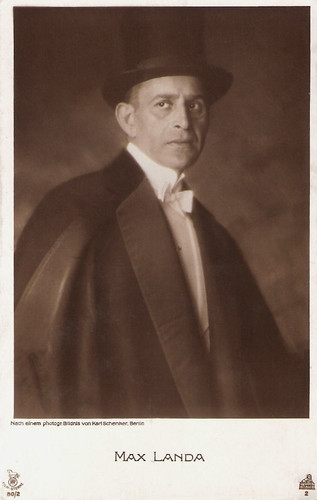
German postcard by Rotophot in the Film Sterne Series, Berlin-Wilm., no. 80/2. Photo: Karl Schenker, Berlin / Oliver-Film, no. 2. Max Landa .
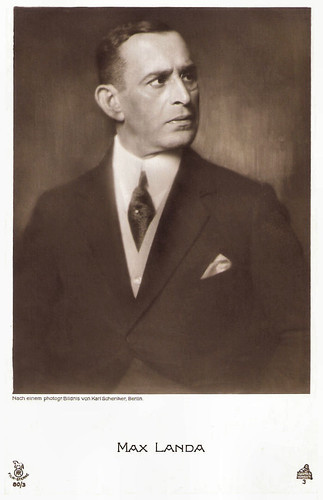
German postcard by Rotophot in the Film Sterne series, Berlin-Wilm., no. 80/3. Photo: Karl Schenker, Berlin / Oliver-Film, no. 3. Max Landa .
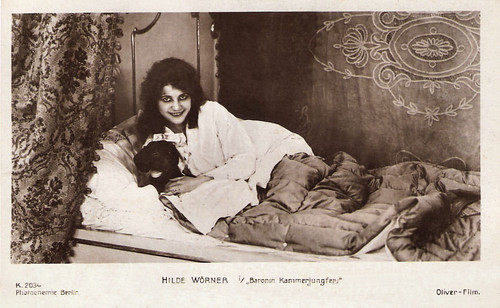
German postcard by Photochemie, Berlin, no. K 2034. Photo: Oliver-Film. Hilde Wörner in Baronin Kammerjungfer/Baroness Kammerjungfer (Leo Peukert, 1917).
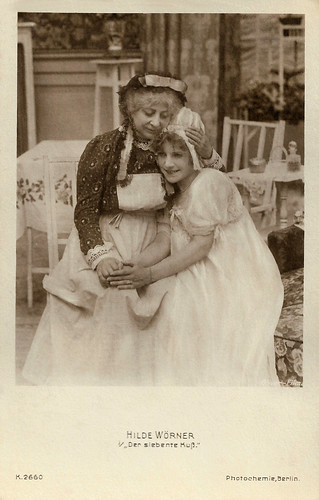
German postcard by Photochemie, Berlin, no. K. 2660. Photo: Oliver-Film. Hilde Wörner in Der siebente Kuß/The Seventh Kiss (Marie Luise Droop, 1918).
Sources: John Mackie (Vancouver Sun), Wikipedia (German), and .

German postcard in the Film-Sterne series by Rotophot, no. 75/2. Photo: Karl Schenker, Berlin / Oliver-Film, no. 2. Dorrit Weixler .

German postcard in the Film-Sterne series by Rotophot, no. 504. Photo: Oliver-Film. Erika Glässner in the silent comedy Das Wäschermädel Seiner Durchlaucht/His Highness's Washing Lady (Danny Kaden, 1917), co-starring Gustav Botz and Karl Beckersachs .

German postcard by Rotophot in the Film Sterne series, no. 505/2. Photo: Oliver-Film. Paul Heidemann in Die Liebesfalle (N.N., 1917).
The business opportunities for a new form of entertainment
David Oliver was born David Olivenbaum, in 1880, in Unizh, Western Galicia (then Austria-Hungary, now Ukraine). He was of the Jewish faith.
To avoid the pogroms that flared up again and again in his homeland, he turned west and opened a cinema in Bremen in 1905, after he had recognised the business opportunities that this new form of entertainment offered him.
Successful as a film salesman, he then built large cinema palaces in Hanover, Dresden, Halle, and above all in Leipzig. Ten years later, he owned his own film company.
When the First World War broke out in 1914, his company, the Berlin Oliver-Film GmbH, controlled around 25 percent of the German film market.
Oliver also headed the Nordische Films Co., so he was head of the German distribution organisation of Nordisk Film, which had been operating in Copenhagen since 1906, and for which top film workers such as Urban Gad, Valdemar Psilander and Asta Nielsen worked or had worked.

German postcard by Verlag Hans Dursthoff, Berlin, no. 996. Photo: Karl Schenker, Berlin / Oliver-Film. Dorrit Weixler .

German postcard by Verlag Hans Dursthoff, Berlin, no. 997. Photo: Karl Schenker, Berlin / Oliver Film. Dorrit Weixler .

German postcard by Verlag Hans Dursthoff, Berlin, no. 1000. Photo: Karl Schenker, Berlin / Oliver Film. Dorrit Weixler .

German postcard in the Film-Sterne series by Rotophot, no. 75/3. Photo: Karl Schenker, Berlin / Oliver-Film, 3. Dorrit Weixler .
One of the founding fathers of Ufa
The Berlin Oliver-Film GmbH produced feature films and documentaries. One of the stars was the Berlin actress Dorrit Weixler , with whom several films were made from 1915 onward, often comedies with her first name in the title.
Another prominent star of Oliver-Film was Hilde Wörner , while the comedians Paul Heidemann (known as Paulchen and Teddy), Erika Glässner , Herbert Paulmüller, Melitta Petri, and Leo Peukert were less frequent stars.
Oliver also produced some detective films with Max Landa , such as Der Mann ohne Kopf/The man without a head (Louis Neher, 1916) and Der Hund mit dem Monokel/The dog with the monocle (Felix Basch, 1916).
The documentaries of Oliver-Film included images of nature and landscapes from the near as well as the more distant surroundings, city portraits as well as general or popular educational character and war reports.
In the Spring of 1915, Oliver acquired Paul Davidson's entire chain of Union theaters. Together with Emil Georg von Stauß and Alexander Grau, he was one of the founding fathers of Ufa in November 1917, after Nordisk had teamed up with other German film companies and the Supreme Army Command under General Erich Ludendorff had given their blessing.

German postcard by Rotophot in the Film Sterne series, no. 505/1. Photo: Oliver-Film. Paul Heidemann in Die Liebesfalle (N.N., 1917).

German postcard by Photochemie, Berlin, no. K. 1935. Photo: Oliver-Film, Berlin. Leo Peukert , Melitta Petri and Herbert Paulmüller

German postcard by Photochemie, Berlin, no. K. 2631. Photo: Oliver-Film, Berlin. Leo Peukert , Melitta Petri and Herbert Paulmüller in Wer niemals einen Rausch gehabt/Who never had an intoxication (Heinrich Bolten-Baeckers, 1918).

German postcard by Photochemie, Berlin, no. K. 2632. Photo: Oliver-Film, Berlin. Leo Peukert , Melitta Petri and Herbert Paulmüller in Wer niemals einen Rausch gehabt/Who never had an intoxication (Heinrich Bolten-Baeckers, 1918).
The largest movie palace in Europe
In the 1920s, David Oliver shifted the focus of his ventures from film production to the rental and theatre business. In Berlin-Charlottenburg he had Hans Poelzig build the Capitol Theater with over 1,300 seats. It opened on 20 December 1925 with the film The Thief of Bagdad (Raoul Walsh, 1924) starring Douglas Fairbanks .
In 1929 Oliver was involved in the construction of what was then the largest movie palace in Europe with 2,667 seats, the magnificent Ufa-Palast in Hamburg.
On 1 April 1933, UFA dismissed all employees of Jewish descent, including Oliver. On 21 March 1934, somebody threw a hand grenade to a taxi in which Oliver was sitting. Oliver remained unharmed but decided to emigrate to Spain.
There he was able to found his own company again, the Iberica Films, and produced some films with it. But he had to flee again after the outbreak of the Civil War in 1936 and the rise of fascism in Spain. This time he moved to England.
In London he helped Alexander Korda, who was himself an immigrant, to set up Denham Studios, which were the most modern studio facilities in the United Kingdom at the time. Until his death, Oliver was head of Denham Studios Laboratories there.
David Oliver died in 1947 in London-Pancras. He was 67 years old. His grandson Mark Oliver (1966) is an actor and film producer in Canada. In 2013 he shot the documentary UFA MAN... The Story of Movie Pioneer David Oliver for HBO about the life and work of his grandfather.

German postcard by Rotophot in the Film Sterne Series, Berlin-Wilm., no. 80/2. Photo: Karl Schenker, Berlin / Oliver-Film, no. 2. Max Landa .

German postcard by Rotophot in the Film Sterne series, Berlin-Wilm., no. 80/3. Photo: Karl Schenker, Berlin / Oliver-Film, no. 3. Max Landa .

German postcard by Photochemie, Berlin, no. K 2034. Photo: Oliver-Film. Hilde Wörner in Baronin Kammerjungfer/Baroness Kammerjungfer (Leo Peukert, 1917).

German postcard by Photochemie, Berlin, no. K. 2660. Photo: Oliver-Film. Hilde Wörner in Der siebente Kuß/The Seventh Kiss (Marie Luise Droop, 1918).
Sources: John Mackie (Vancouver Sun), Wikipedia (German), and .
Published on October 16, 2020 22:00
Paul van Yperen's Blog
- Paul van Yperen's profile
- 13 followers
Paul van Yperen isn't a Goodreads Author
(yet),
but they
do have a blog,
so here are some recent posts imported from
their feed.



